The Elements of Art Eight tools, infinite expression
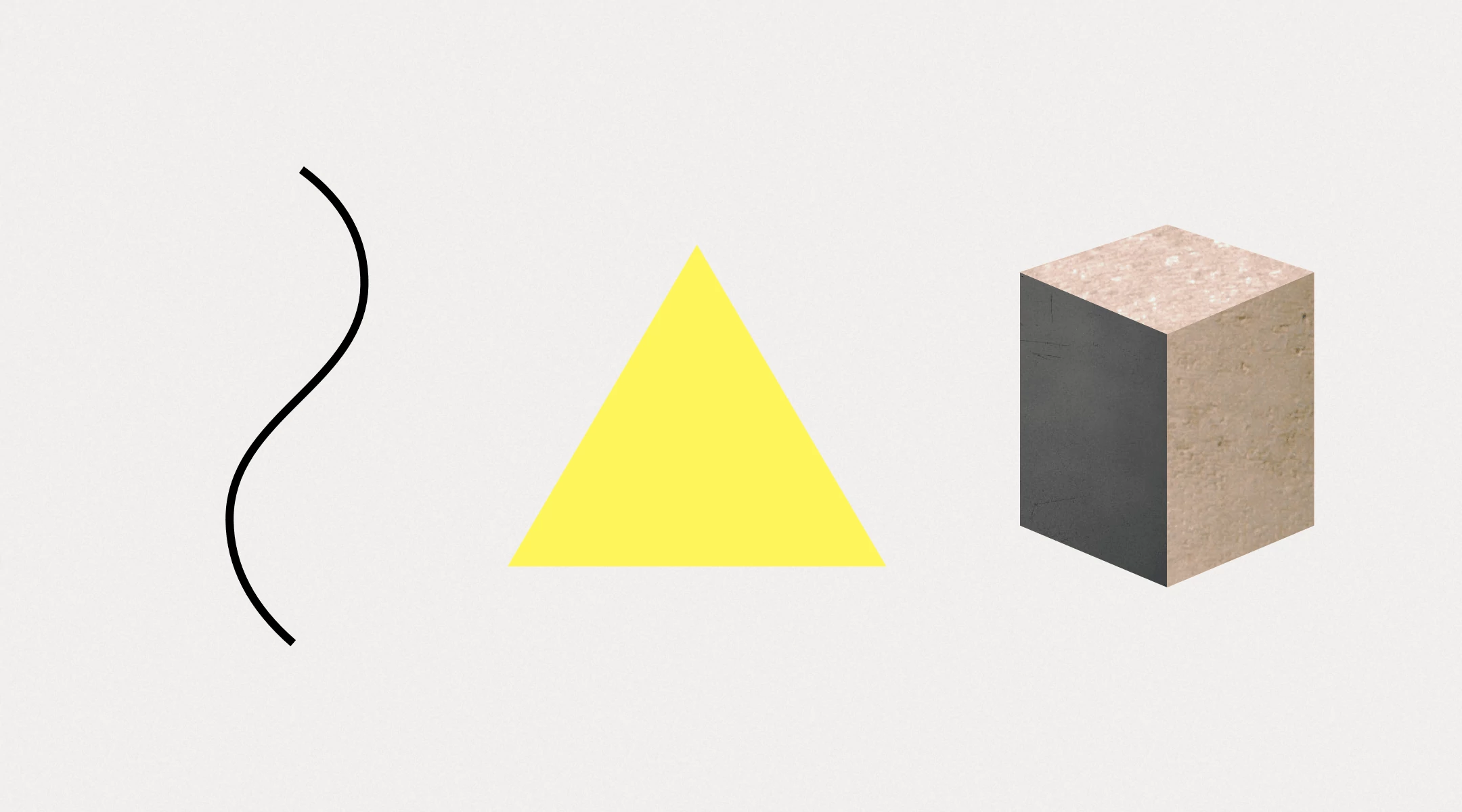
All artwork speaks the same language through a vocabulary of eight terms expressed in infinite ways. We all understand the vocabulary of art subconsciously, but recognizing how it’s applied enriches our experience of art and allows for nuanced discussion of artworks and appreciation of the artist's passion and skill. The vocabulary of art is made up of the Formal Elements of Design: line, shape, form, space, color, texture, motion, and time.

The most basic element of design is the line: a mark with greater length than width, the path traced by a moving point. In mathematics, a line has no width, but in art, lines can be thin, thick, rough or smooth. Lines can convey tremendous emotion, from aggressive zig-zags or tranquil waves to nauseating spirals. Artists can convey confidence in bold lines, or precision with straight lines.

A shape is formed when lines enclose a space. The edges of the shape are its contour, which can be geometric or organic, open or closed. Like lines, shapes can be expressive, sharp or soft, architecturally rigid or flowing. Simple shapes form a common vocabulary that stretches back millenia, often associated with specific attributes. Roman Architects believed the circle to be divinely perfect, and used it when designing their temples. Triangles were imagined to point to the heavens.

Form is the real or perceived dimensionality of a shape, expressing length, width, and depth. Spheres, cubes, pyramids are three-dimensional forms, and some of the fundamental building blocks for expression in art. Form can also describe the structure of a work of art. The composition of a painting or the chapters of a book. Form can be used to talk about the arrangement of formal elements that present the whole.

Space is the area between and around objects. In art and design, the space is as important as the forms it surrounds. Space can be two or three dimensional, and is often referred to as negative space. Space holds the objects it contains, providing context. Space is as emotive as lines and shapes, and can create feelings of isolation, claustrofobia, or wide open possibility.

Color is possibly the most complex tool at the artist's disposal. Color is scientifically defined as the light that reflects off illuminated objects, whose pigmentation absorbs some wavelengths, and the wavelengths that remain enter the eye. The colors we see are part of the visible spectrum: red, orange, yellow, green, blue, and indigo, but these colors combine into millions of perceivable colors. To talk about the variations of colors, we use the terms hue, value, and intensity. Hue defines the range the color sits within, like a greenish yellow or a yellowy green. Value is the relative lightness or darkness of the color, and intensity is the relative brightness or dullness of the color.

Texture comes from the latin word texo , meaning 'to weave' and refers to the qualities of a material surface. Texture may be seen and felt in dimensional objects, such as canvas or a marble sculpture, and two-dimensional objects can create the illusion of texture, like a photograph of a rough wooden surface. Texture can be evocative. Smooth objects can feel refined, and rough surfaces may create a gritty, aggressive appearance.

Motion is the movement or change of an object over time. In art motion can be applied to sculpture, called kinetic sculpture , and is a natural element of video and performance art.

The effect of time on artwork is an oft overlooked element of design. All objects change over time, though in different ways. A stone artifact from 30,000 BCE may be nearly unchanged from the time of its creation, but paintings fade. Time is also part of how we consume art. A book may take weeks to read, and that time creates a different context for the experience than an article read in minutes. Video uses time the same way a painter uses negative space, employing pacing, momentum, and balance over the length of the film.
Reed Enger, "The Elements of Art, Eight tools, infinite expression," in Obelisk Art History , Published June 24, 2017; last modified November 08, 2022, http://www.arthistoryproject.com/essays/the-elements-of-art/.


Art History Methodologies
Eight ways to understand art
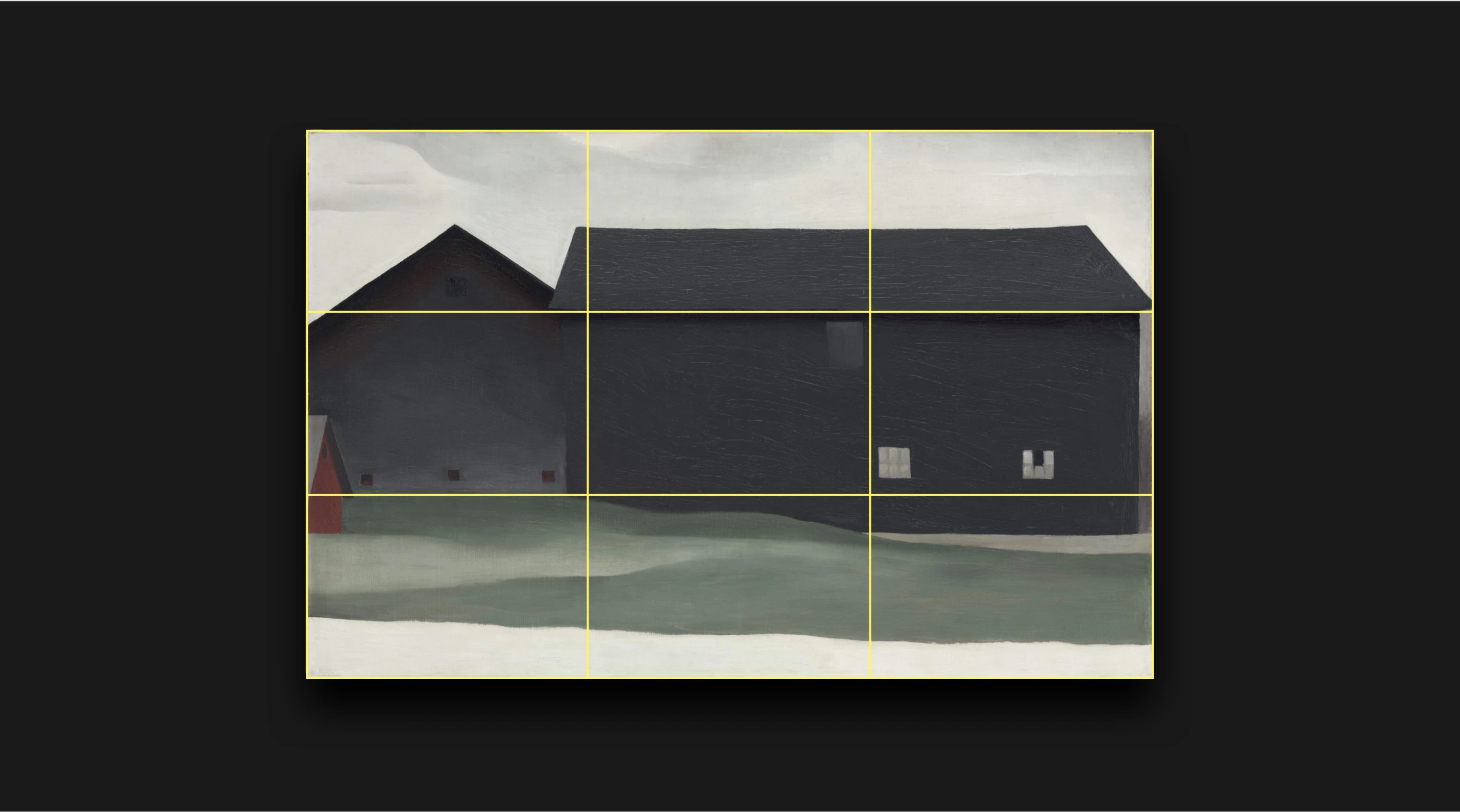
Basic Composition Techniques
A few easy tips
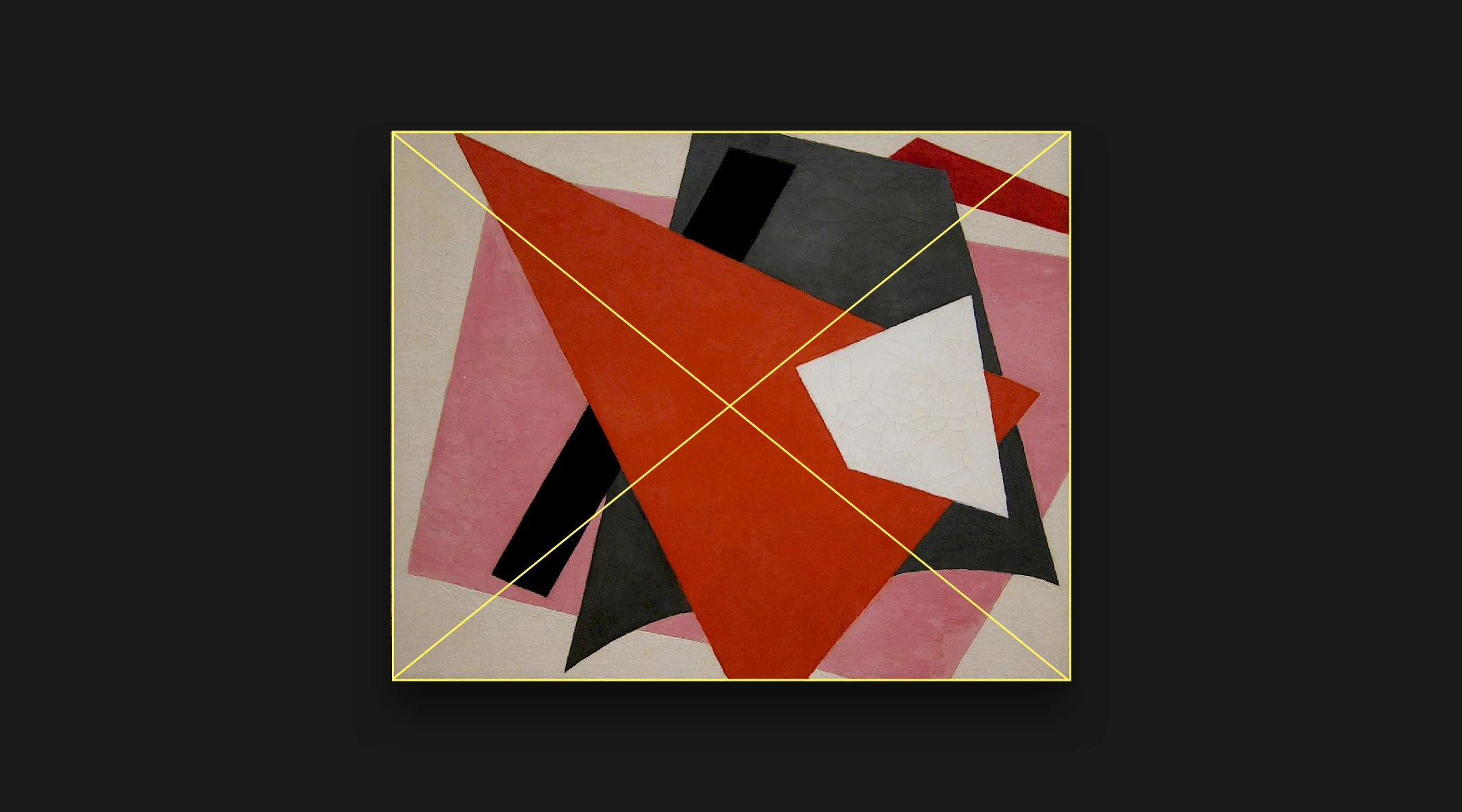
What is Artistic Composition?
Geometry and the Subconscious
By continuing to browse Obelisk you agree to our Cookie Policy

The 7 Elements of Art

Introduction
Every time you create an artwork there are 7 elements, or components, that your artworks consists of. More often than not we just take these elements for granted, or don't even give them a second thought.
They are however critical to the success of your artwork. By keeping them in mind as plan and create your artwork, you will end up with a much better artwork.
One that will be easier to look at as the person's eye will flow through your artwork more fluently. You will have control over how their eye moves through your painting - you will be able to lead them through the painting.
This is just one of the benefits of knowing the 7 elements of art. Let's dive right in by looking at what these 7 elements are:
What are the 7 Elements of Art?
The seven elements of art are line, shape, form, space, value, color and texture. These elements are the essential components, or building blocks, of any artwork. Any good artwork should consist of these 7 ingredients.
Element 1 - Line
Line is the most basic element of art. Without line the other elements couldn’t exist so let's start here and then we will gradually go more advanced.
A line can be thought of as a moving dot. If the dots overlap, it’s a solid line, if they don’t it’s a dotted line. A line has a beginning and an end and by its existence, creates an edge.
If a line joins up it forms an outline (also called a contour). An outline creates a shape.
Lines can be:
Long or short
Thick or thin A thick line gives emphasis and advances while a thin line recedes.

Straight Straight lines on the other hand are more mechanistic and dynamic and rarely found in nature.

Curved Curved lines change direction gently with no sharp angles and suggest comfort and ease to the viewer. Curved lines most often relate to the natural world.

Zigzag Zigzag lines alter direction fast and create feelings of unrest, turmoil and movement.

Diagonal Diagonal lines, give movement and dynamism to a composition.

Horizontal Horizontal lines create the feeling of stability and calm.

Vertical Vertical lines give the impression of height and strength and often have a spiritual connotation.

Imaginary Lines can be imaginary or implied; for example line of sight can be a very strong albeit invisible line along which the viewer’s eye travels. Also a pointing finger can send the viewers eye on a journey through the painting.

Three Dimensional Lines alone can also be used to create a three dimensional effect, (depth, in a 2-dimensional artwork. Hatching lines (straight or curved) are used to turn shape into form using value as seen the works of the masters like Rembrandt.
In summary lines can:
- Describe 2-dimensional shapes and 3-dimensional forms
- Create feelings of movement and emotion
- Create value and thereby show the direction of light
- Change 2-dimensional shapes into 3-dimensional forms with value
- Depict texture
Element 2 - Shape
When a line meets up to enclose a space, a shape is formed.
Shapes can be:
Geometric or organic.

Shapes are 2-dimensional, i.e. they have height and width but no depth e.g. a square. The best way to remember the shape element is to think of an outline.

Positive or Negative Shapes
The object you draw on your page is a shape enclosed in a frame. This frame may be a box you drew to designate the edges of your drawing area or the edge of the page if you didn’t draw a box. The object you draw is the positive shape. The rest of the space in your box (or if you didn’t draw a box then the rest of the page) is called negative shape.
Element 3 - Form

Form is the next step up from shape as we now add depth to it to create a three dimensional form.
A square (shape) vs a cube, a triangle vs a cone etc. etc. Form encloses volume i.e. height, width as well as depth.
In drawing and painting form can only be implied because they are 2-dimesional (flat) media. Artists must use tricks to fool the viewer’s eye so as to create the illusion of the third dimension i.e. depth. This is known as Trompe l’oeil and is achieved using tools like value (shading), colour and contour lines.
Here you can see how shading has been used to create the illusion of 3-dimensional objects on a flat wall:

Like shapes, forms can be geometric or organic.
Organic forms are common in nature while geometric forms are more characteristic of architecture and man-made items. Nature however also uses geometric forms on occasion. Examples are crystals and honeycombs.
Element 4 - Space
Space is what lies between, around or within an object.
To show space in a 2-dimensional medium the artist must use techniques to create the illusion of space between items that are in reality on a flat surface.
How do artists create this feeling of space between objects?

Overlapping
When an object is drawn or painted on top of another object the viewer’s eye interprets this as one object being in front of another implying there must be a space between them.

Objects higher up in the picture plane will seem to the viewer’s eye to be further away than objects placed low down in the picture frame.
Smaller objects look as if they are further away than larger objects. Notice how much smaller the house is in relation to the flowers.

The further away an object, the less detail is visible to the viewer. By purposely reducing the amount of detail in an object it will appear further away than an object with greater detail.

Colour and Value
Objects in the distance usually appear cooler (bluer) and lighter in colour. Close up objects appear warmer and darker in value.
Perspective
Can be used to create the feeling of depth on a 2-dimensional surface. The most commonly used perspective types are linear and 2-point perspective.
Negative Space
Space can be either positive or negative in the same way as shapes can.
Negative space is all around the object, which is the (positive space) subject of the painting.
Negative space is very important and an artist must plan the negative space as carefully as the main subject.
Is there enough negative space to give the subject room to “breathe” or does it appear boxed in?
Negative space can be cut to a minimum or eliminated entirely for a very close up and intimate focus on the subject.
It can be greater on one side than the other, or greater at the top or bottom.
All choices which will affect how the viewer sees the overall composition.
Element 5 - Value

Value is how light or dark something is.
There is a scale of light and dark from pure white through to pitch black. The value of a colour depends on how light or dark it is compared to the value scale.
Getting the values right is more important than getting the colours right in painting. Value is what makes it possible to show 3-dimensional forms in a 2-dimensional surface.
By increasing differences in value, contrast is increased as well. A highlight will look brighter when surrounded by a dark value. Decreasing contrast will make objects visually recede into the picture plane and draw less attention.
The focal point of a painting is where you want to add the most contrast as this high contrast automatically draws the viewer’s eye.

If a painting is done on the lower (darker) edge of the value scale it is called a “low key” painting. Low key paintings give rise to a heavy, mysterious, dramatic, sometimes brooding feeling in the viewer.

By contrast “high key” paintings take their range of values from the upper end of the value scale and create emotions of lightness, quickness, spirituality etc.
Most paintings however use the full range of values from light to dark.
Value is what artists use to portray light and form. The further from the light the darker the value.

How value changes determines the form of an object.
If there’s a gradual transition in value it conveys to the viewer that the surface is gently rounded. This is called a soft edge.
If however there is a rapid transition between values it means there is an edge. This is called a hard edge.
Value is also used to create shadows which show light direction and anchor the object, preventing it from appearing as though it is floating.
Element 6 - Colour

Colour is created when light is reflected into the viewer’s eye.
In art, colours are arranged on a colour wheel. The colour wheel was developed by Isaac Newton who took the colour spectrum and bent it into a circle.
The colour wheel shows primary colours, (colours that can’t be mixed), secondary colours (made by mixing two primaries) and tertiary colours (made by mixing a primary and secondary colour).
Colour theory helps the artist to mix desired colours from primary colours. It’s only a theory and can’t be proven but it is nevertheless useful to the artist. Colour theory is based on the colour wheel, colour value and on which colours work well together - also called colour schemes.
There are various colour schemes which define the primaries. The most common is the Red, Yellow, Blue model. Another popular scheme uses Cyan, Magenta and Yellow as the primaries. There are several other and each works well in different situations.
Colour is described by its hue – red, green etc. (Hue the name we give a colour.)
A colour has intensity called chroma, also known as saturation, brightness or purity. The more pure the colour is (less of other colours mixed in), the more intense or saturated it is. In painting only small amounts of saturated colours are usually used as accents. Too much saturated colour can give a garish result. The chroma of a colour is not the same as its value.
Colours also have value. Value is how light or dark the colour is, as discussed in Element 5 above. Each colour falls on the value scale from light to dark. Yellow would be near the top (light end) of the scale while purple would be found near the bottom end. To change the value of a colour you follow the Colour Mixing Rules .

Art supply stores sell interactive colour wheels which are essential to the artist working with colour. I recommend this Color Wheel .
Element 7 - Texture

Actual texture is the way an object feels to the touch.
Drawing or painting texture on a 2–dimensional, flat surface is a challenge for artists. The artist must instead convey the illusion of the actual texture to the viewer on the flat surface.
How this is done is by the careful use of value and specific marks / brush strokes which then mimic the actual texture.
Every textured surface reflects light in a very particular way. Think of the difference in texture between a chrome ball and a concrete ball. The artist, through careful observation and the use of light and dark values, recreates this actual texture visually on the picture plane.
You can follow our tutorial in Drawing Weathered Textures to get a feel for how this is done.

It is possible to create actual 3D texture on a flat surface by the addition of texturing compounds which create a raised surface. Impasto paste is one way or you could even add sand etc. to the paint. Even thick paint will leave the texture of the brush marks for the viewer to see.
You can follow our tutorial on Texture Painting Techniques to see how you can add texture to your canvas.

It is also possible to create patterns by the repetition of shapes that creates 2D texture. This is often used in Op Art. (Optical Art).
I think you will agree that you have been using many of the seven elements throughout your artworks without even realising it.
Now that you are however aware of these elements, you can look out for them as well as look out for ways to incorporate more of them into your artworks.
This will add extra depth, dimension, texture and interest to your artworks, taking them to a whole new level.

About Nolan Clark
Read more about Nolan Clark
Follow Us on :
Copyright © · Paint Basket TV · All Rights Reserved
As an Amazon Associate, I earn from qualifying purchases.
Pin It on Pinterest

Elements of Art
The elements of art are the fundamental components used by artists when creating a work of art. These elements, often referred to as the building blocks of art, include line, shape, value, colour, space, texture, and form. Artists use all of these elements together help create the composition of an artwork, to express meaning and to create the impression of a scene or subject.
In this guide, discover what the elements of art are and how you can use them to create successful compositions.
Disclaimer: Fine Art Tutorials is a reader supported site. When you make purchases through links on this site, we may earn a small commission at no extra cost to you.

Line is one of the most basic elements of art and it can be used to create many different effects. Lines can be straight, curved, angular or organic and they may be thick or thin. They can also denote direction, such as horizontal or diagonal. Lines can also be used to suggest movement, value, depth and texture within a piece of art.

An artwork can be created with just line alone, look at line art drawings, where artists use pens or pencils alongside the hatching or cross hatching techniques to create the impression of light and shadow in different subjects.

Shapes are two-dimensional forms that are defined by an outline or border. They can be geometric such as squares, circles and triangles, or organic like free-form shapes. Artists use shapes to represent a subject, for example, drawing the shape of a leaf in a landscape piece.

Complex shapes draw more attention from the viewer than simple shapes and large shapes draw more attention than smaller shapes, due to the inherent visual weight these types of characteristics have. William Morris repeated shapes and design motifs in his designs to create his famous patterns . The shapes all appear complex, organic and representational .

Value is the lightness or darkness of a colour used in an artwork. Light and dark values create depth and perspective and also emphasise certain elements within a composition. Value is created by mixing black or white with a colour.
Denman Ross created the value scale in 1907. In the Denman Ross value scale, 1 represents white and 9 represents black. Using a value scale can help artists determine relative values in their reference, which can aid them in mixing. For example, it can tell artists how much black or white to mix into their colours to match it to the colours in their reference.
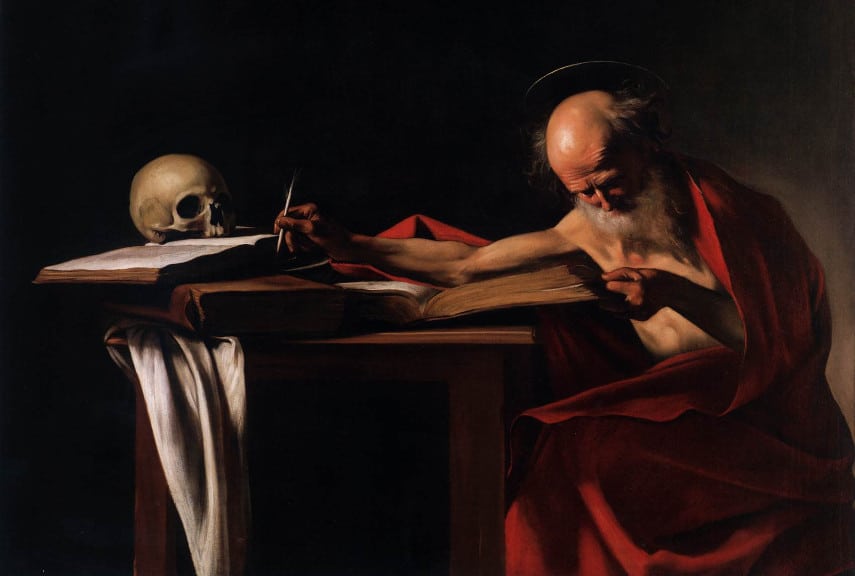
Chiaroscuro is the technique of using highly contrasting light and dark values in an artwork. Oil painters such as Caravaggio and Rembrandt used this technique in their oil paintings to create drama, atmosphere and focal points.
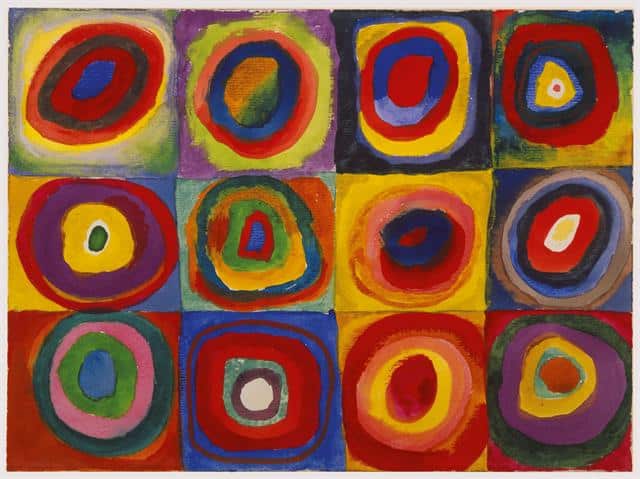
Colour is an important element of art which helps to bring life to an artwork. Colour is the way in which humans perceive wavelengths of light and is further categorised by hue, saturation and luminance.
Primary colours such as red, blue and can be mixed to create secondary and tertiary colours. In art, these primary and secondary colours correspond to particular pigments which can be mixed to create new tones and hues.
Colours evoke different feelings in people and they can be used to help express an artist’s emotional state. Colour theory is the study of the applications of colour in art and is an important concept to understand when creating artworks, as it can help artists to become faster and more accurate at colour mixing and help artists create colour harmony with intent in their designs.
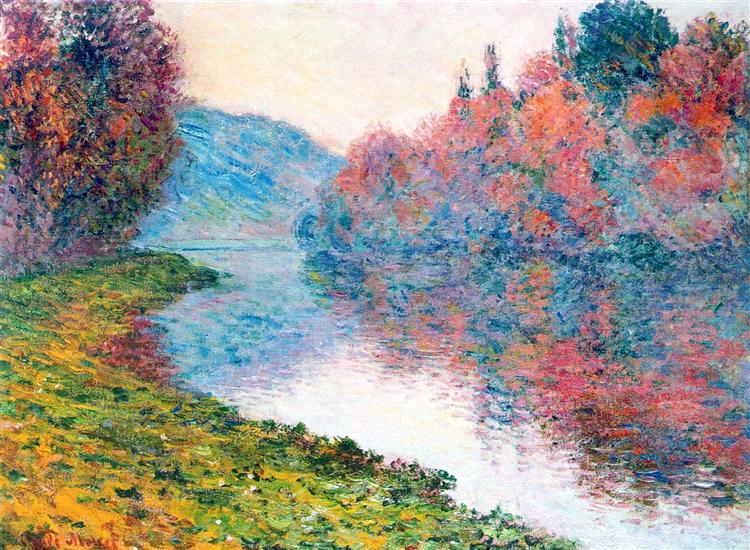
Artists may also choose to use a colour scheme in their artwork to bring unity to a painting. Monet used colour schemes extensively in his paintings. The split complementary scheme in the ‘Banks of the Seine at Jenfosse’ creates variety , whilst unifying different sections of the painting.

Space is the area around, within and between shapes that creates a sense of depth within an artwork. Positive space is defined as the space in artworks occupied by subject or objects, while negative space is the area around and between the subjects. Negative space could include the background, or sky for instance, however this can depend on the context of the artwork. You can see how Escher uses positive and negative space cleverly in his artwork ‘Metamorphosis II’. The repeated elements of the insects on the left morph into appearing as negative space between the fish in the middle, then transform into bird shapes on the right hand side of the artwork. Escher played with using similar shapes and consistent values to create a transformation of occupied space in this artwork.

Depending on how the artist has chosen to position and space elements within an artwork, feelings of harmony , unity and tension can be created. When subjects and objects are placed within close proximity of one another, it can create a sense of tension but also a sense of unity . However, when subjects and objects are more evenly space, the composition will appear more balanced .
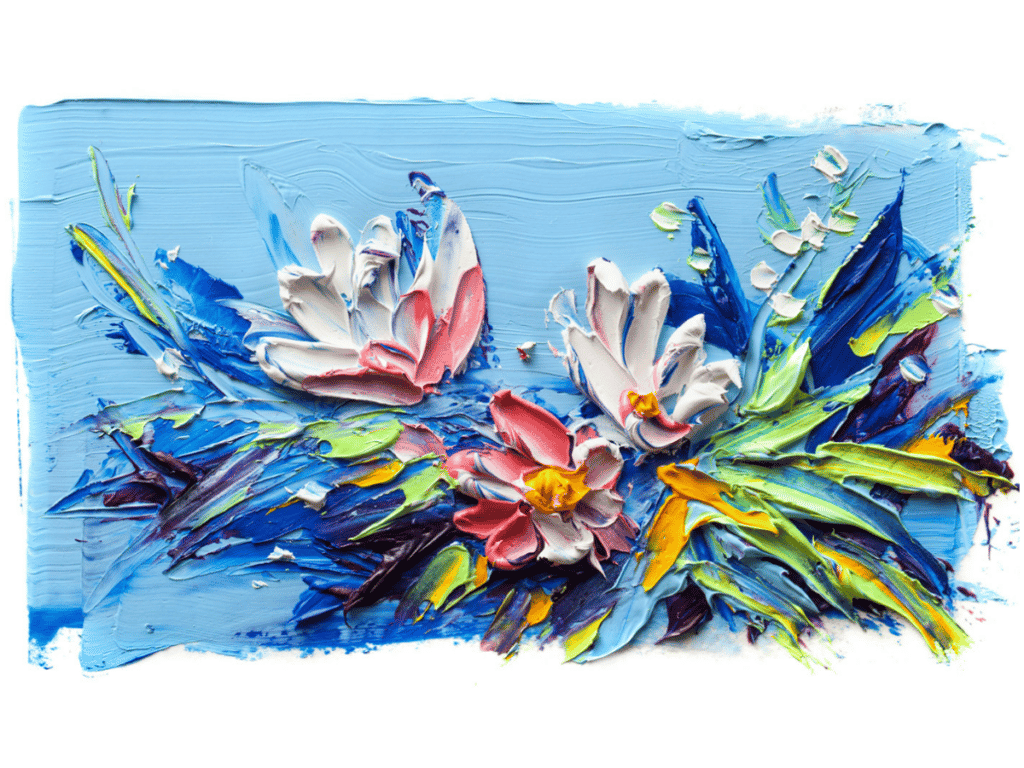
Texture refers to the surface quality of an object or material that can be seen and felt. It can make a painting look more three-dimensional or realistic and it also helps to create a sense of depth, movement and rhythm .
Sculptures have inherent texture to them, with paint, artists can add additives to paint to enhance texture. For example, by adding cold wax to oil paint, it will thicken the mixture and make the paint retain brushstrokes on the canvas.

Form is a three-dimensional object that has mass and volume. It occupies space and it can be viewed from any angle. Sculptures are considered to have three dimensional form, while subjects within a painting can have the appearance of form. Forms can be organic or geometric, simple or complex and either abstract or representational. When using media to create two dimensional artworks, such as pencil or paint, artists can create the impression of form by using shape, colour and values to give the illusion of three dimensionality.
Examples: Elements of art
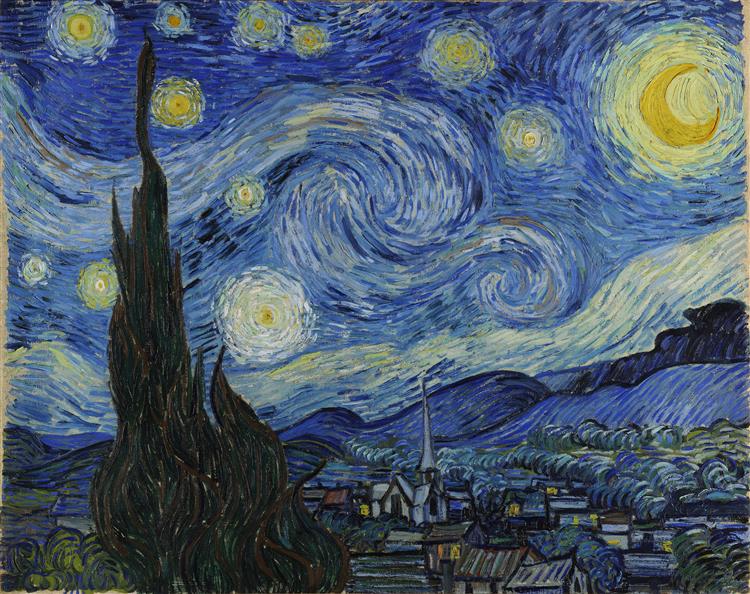
Vincent van Gogh used the elements of art in interesting and unique ways to create novel, symbolic and eye catching compositions. For example, he used the complementary colour scheme of purple and yellow in his famous painting ‘The Starry Night’ to create contrast and dynamism. Additionally, the use of repeated, textured brush strokes creates a sense of movement and rhythm. The brushstrokes appear as lines moving and swirling in the sky, which adds to the sense of atmosphere in the piece.

Gustav Klimt use different elements to create harmony and variety in his artworks. For example, in his painting ‘The Kiss’, he repeats geometric, simple shapes across the clothing of the figures, creating subtle contrast and variety by introducing blocks of colour. The repeated elements unify the design and create rhythm.
Principles of design
The principles of design are the effects that can be created by arranging visual elements in such a way to create a successful composition . These include balance, contrast, emphasis , repetition , variety, proportion , scale , movement, pattern, rhythm and unity.
Balance can be achieved through a symmetrical or an asymmetrical composition ; artists use this by arranging their elements in such a way that it feels harmonious and unified. For example, the artist could repeat a similar shape on one side of the canvas to match a shape on the other. This symmetry offers balance to the composition.
Artists can create the effect of contrast by using elements that are dissimilar to one another together. For example, colours on opposite ends of the colour wheel contrast with each other, because they are dissimilar in hue. By placing orange next to blue, the two colours contrast against and therefore emphasise each other.
Formal analysis
Formal analysis is the process of looking at and examining the elements, principles and techniques used in an artwork. By observing an artwork and breaking it down into its component parts, one can gain deeper understanding of how the elements interact with each other to create a unique composition. Viewers can also elicit important information about the context of the artwork, such as the style of the artist , the date it may have been created and the meaning behind the work. This can help to identify which techniques were used to create the artwork and why.

For instance, Impressionist artists such as Monet used looser shapes to represent subjects, compared to Renaissance artists , with more textured brush strokes and more vivid colours. This is a style that was common during the 19th century. By doing a formal analysis of a painting like this, the viewer could glean information such as the century that the painting might have been from and the intent behind representing the subject in this manner.
Visual weight of elements
The visual weight of an element is determined by its size, shape, colour and value. Larger shapes or darker colours tend to have more visual weight than smaller shapes or lighter colours. This is because they appear to be more dominant on the canvas and draw the eye’s attention more.

For example, in a portrait piece, the artist might use dark tones to emphasise certain features of the subject’s face. This would draw viewer’s attention to these points on the canvas and create focus.
The importance of the elements of art
The elements of art are the building blocks of any artwork. By understanding and using each element effectively, an artist can create compositions that have clarity and purpose. Study how to use them in combination with one another, to create visual effects such as balance or contrast. The visual weight of elements is also important in creating focus and emphasis on particular points of the composition.
Formal analysis is a great tool for understanding the elements of art and how they interact together in a piece. Viewers can understand the style and context of artwork by looking at how the visual elements created it.
Overall, the elements of art are important components in creating a successful artwork. Knowing how to use them effectively will help any artist in creating compositions that have impact and meaning.
How to Write About Art
Writing about Art can be tricky! Help and advice is just a click away …
Elements of Art
There are a number of elements every artist can choose from when they make their art. They may draw a line, make shapes, add shading to create depth, use colour, arrange the picture in a particular way on the page, use tones, create or diminish space. When writing about art, it is important to be aware of all these elements and comment on them in your essay, giving both a description as well as saying something about the effect it has. This section gives an overview of 7 elements and some writing exercises. There are also individual posts on the elements – so take a look at those too.
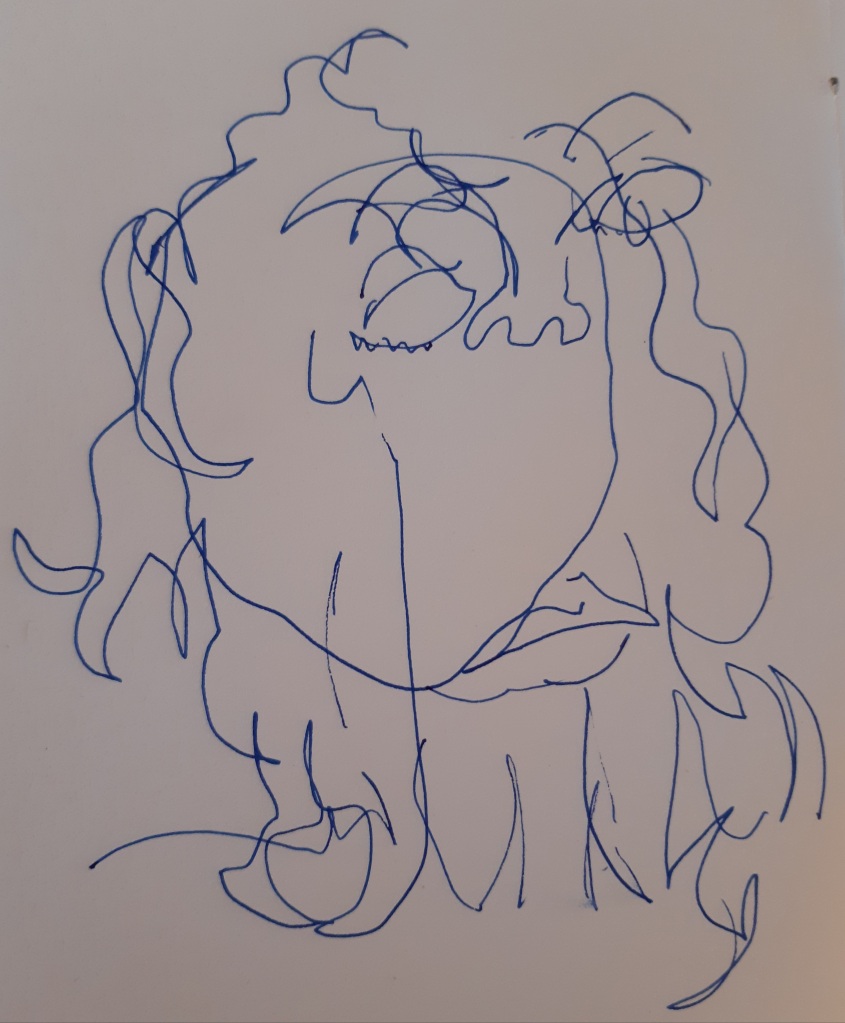
Line – enough said?
A simple line is just a simple line, isn’t it? Not much to say! Well, that’s where you would be wrong! Line might be the most simple and basic feature an artist uses, but there is a lot to say about it.
Let’s consider two things: i) describing the line; ii) writing about the effects of the line.
i) Describing the Line:
- width – thick, thin, bold, pale
- direction – straight, curved, diagonal
- quality – continuous, broken, smooth, jagged
- Different kinds of Line : outlines/contour lines; hatch lines; crosshatch lines
ii) Effects of the line:
- movement, dynamic, fluid
- sturdy, rigid,
- expressive – calm, anger, jarring, serene
- delicate, confident
So much can be said just about Line!
FIRST – LOOK! It is really, really important always to look at the Artwork and keep looking! Everything you write has to have its basis in the actual Artwork. That might sound very basic, but it’s easy to get carried away with what we think we have seen, rather than comment on what is actually in the Artwork.
SECOND – WHAT IS NOT THERE? In choosing to draw a line in one way, the artist has decided against creating the line in another way. That is worth mentioning.
Artists such as Picasso has made some delightful Artworks just using line. Michael Craig-Martin also has done some interesting things with line – superimposing one outline on another in his Artworks in the 1980’s. See https://wordpress.com/block-editor/post/howtowriteaboutart.com/119
Artists who do book illustrations can use line predominantly, to great effect. See the effect that John Minton created https://wordpress.com/post/howtowriteaboutart.com/325 as well as the work of Brian Wildsmith https://wordpress.com/post/howtowriteaboutart.com/205
When you are analysing a piece of Art and writing about it you can comment on the shapes in the work, describing them, as well as saying something about the effect they have. Put simply, a shape is an enclosed area in two dimensions, having height and width but not depth. It is created by enclosing an area, and this can be done with an outline, surrounding an area with other shapes or placing textures in particular positions. We might categorise shapes into geometric shapes and organic shapes.
Description: Geometric shapes : – mathematical shapes that are perfect and regular: straight lines, angles, points, circle.
Effect of Geometric shapes : gives a sense of balance, order, repetitive; can highlight that something is a human creation/invention, artificial, uniform. These shapes can also convey emotions that might be hard and harsh – jagged lines for a disquiet atmosphere
Description: Organic shapes : shapes occurring in nature, irregular; curves, flowing, variation
Effect of Organic shape : gives a sense of uniqueness, unrepeatability, not repetitive, natural and therefore ‘true’. These shapes can also convey emotions such as calmness, serenity, love, peace.
LOOK : make sure that you look closely at the Artwork so that you can describe elements accurately, and also think about how it makes you feel – what are the effects, and write that down too.
Think about the effect that P icasso creates through the use of organic shapes and geometric shapes in his two paintings The Dream , and The Weeping Woman . See my post ‘Shape: Weeping and Dreaming’. https://howtowriteaboutart.com/2020/08/28/shapes-dreaming-and-weeping/
An artist will use techniques to create objects that look three-dimensional on the flat, two-dimensional surface. This creates Form. While Shapes have the two dimensions of length and width, Form creates a sense of depth and volume. An example of this is when the Shape of a circle, looking flat like a disc, is given volume by the use of tones or shading by which it becomes a Form.
Space is the area that surrounds objects. Photographers capture space and architects build space but in painting space is created as an illusion, transforming the two-dimensional surface to appear to contain a three-dimensional scene.
Space can be conveyed by linear perspective , which was an innovation in Western art in the fifteenth-century, which helps the picture appear to have depth. It is as if the viewer is looking through a window onto the scene. By having a vanishing point , where the lines in a painting converge in one place, and by painting nearer objects larger than distant objects, an illusion of three-dimensional space is created. Atmospheric perspective is created through the contrast of strong colours in the foreground and paler colours in the background: this is particularly important in landscape painting. Have a look at how I used this: https://wordpress.com/block-editor/post/howtowriteaboutart.com/273
Negative space is the space around objects, and positive space is the space taken up by objects. Click here for an example: https://wordpress.com/block-editor/post/howtowriteaboutart.com/278
Non-linear perspective is a flatter use of pictorial space, found in the traditions of many non-Western cultures. Space is created through overlapping objects, making objects different sizes or objects placed vertically to convey distance. In such works, vantage points are created rather than vanishing points.
Overturning linear space . At the beginning of the twentieth century, artists such as Picasso and Braque developed a new sense of space by amalgamating different points of view and light sources, and presenting their subject matter in many ways at once, shifting the foreground, middle ground and background.
See John Minton’s illustrations and an analysis of his creation of space https://howtowriteaboutart.com/2020/11/15/space-and-substance/
5. Value and Contrast
Value is the degree of lightness or darkness created by an artist in their work; the difference between values is called value contrast . The lightest value is white and the darkest value is black. Placing lighter areas of value against much darker ones creates a dynamic effect, which can be used deliberately by the artist. Low contrast can give a much more subtle, much less dynamic effect which could be used intentionally by an artist to convey mood and create an atmosphere. The Italian term chiaroscuro refers specifically to the use of light and dark in a piece of art – and the Baroque painter, Caravaggio used this technique with consummate skill.
A whole array of emotions can be conveyed and evoked through the use of colour alone, by using different hues, different values and different intensities. Colour can be used symbolically, to create a pattern or to convey a specific mood. Colour theory is the study of colour in art and design, and it categorises colour into primary [red, blue and yellow], secondary[orange, green, and violet] and tertiary [obtained by mixing one primary colour and one secondary colour]. White and black are not considered colours and can be used to lighten a colour by adding white [called a tint ], or to make a colour darker by adding black [called a shade ].
Hans Hofmann used colour in a distinctive way – referred to as the ‘push and pull’ theory whereby he created depth in pictures just through playing off the dynamics of one colour against another. See https://wordpress.com/block-editor/post/howtowriteaboutart.com/299
Texture is the look and feel of a surface. Some art movements have tried to create little texture, thinking that smoothness and invisible brush strokes is the measure of excellence. Many modern artists, however, have positively exploited textures to create effects and to reveal the painterliness of their art.
Share this:

- Already have a WordPress.com account? Log in now.
- Subscribe Subscribed
- Copy shortlink
- Report this content
- View post in Reader
- Manage subscriptions
- Collapse this bar

Elements of Art – An Analysis of the Seven Art Elements
Did you know that when you look at a work of art, you are really looking at several art elements composing it? Like an orchestra, each instrument has a part to play, culminating in a beautiful visual symphony. In this article, we will unpack the building blocks of art that will help you recognize how art elements are used to establish a sense of completeness and how one can distinguish between the art elements and principles of art. Read on to learn more about these fundamental elements!
Table of Contents
- 1.1 What About the Principles of Art?
- 2.1.1 Color Science and the Color Wheel
- 2.1.2 Temperature in Color
- 2.1.3 Color Intensity and Saturation
- 2.2 Value
- 2.3 Texture
- 3.1 What Are the Elements of Art?
- 3.2 How Many Art Elements Are There?
- 3.3 Why Are the Elements of Art Important?
The Fundamentals: What Are the Elements of Art?
In simple terms, the elements of art are understood as the parts that make up a single work of art. These are often described as methods or components in the visual arts . There are typically seven primary elements of art namely; color, value, line, shape, form, texture, and space. We will discuss each of these in more detail below.
Artists can apply the seven elements of art in numerous different ways to create artworks that are visually appealing and expressive.
Art elements can apply to almost all types of artworks, including paintings, drawings, designs, or any other form of visual composition. So, why is it so important? It is important to understand the elements of art if you are an art student, or even if you are an art enthusiast because they act as guidelines or tools to not only compose an artwork but to analyze it. Furthermore, in planning how to incorporate such elements in your artwork, you can be sure to guide the viewer’s eye to your intended subject. Once the art elements are understood, the possibilities are seemingly endless as to how they can be applied. Here is the overview:
Have you ever looked at a painting without knowing what the elements of art are? Did it just look like a picture to you? Without the knowledge of these tools, we are not able to go deeper into the underlying structure of visual composition. In other words, art elements provide the framework for understanding an artwork.
It is almost like learning a language, such that each element of art plays a role in forming a visual “sentence”.
As such, some art sources describe the elements of art as a form of “visual literacy” that all those who wish to engage with it in a meaningful way, should strive to learn. So, the next time you visit an art gallery , you can be sure to better appreciate the work of art, whether it be a complex sculpture or minimalist painting.
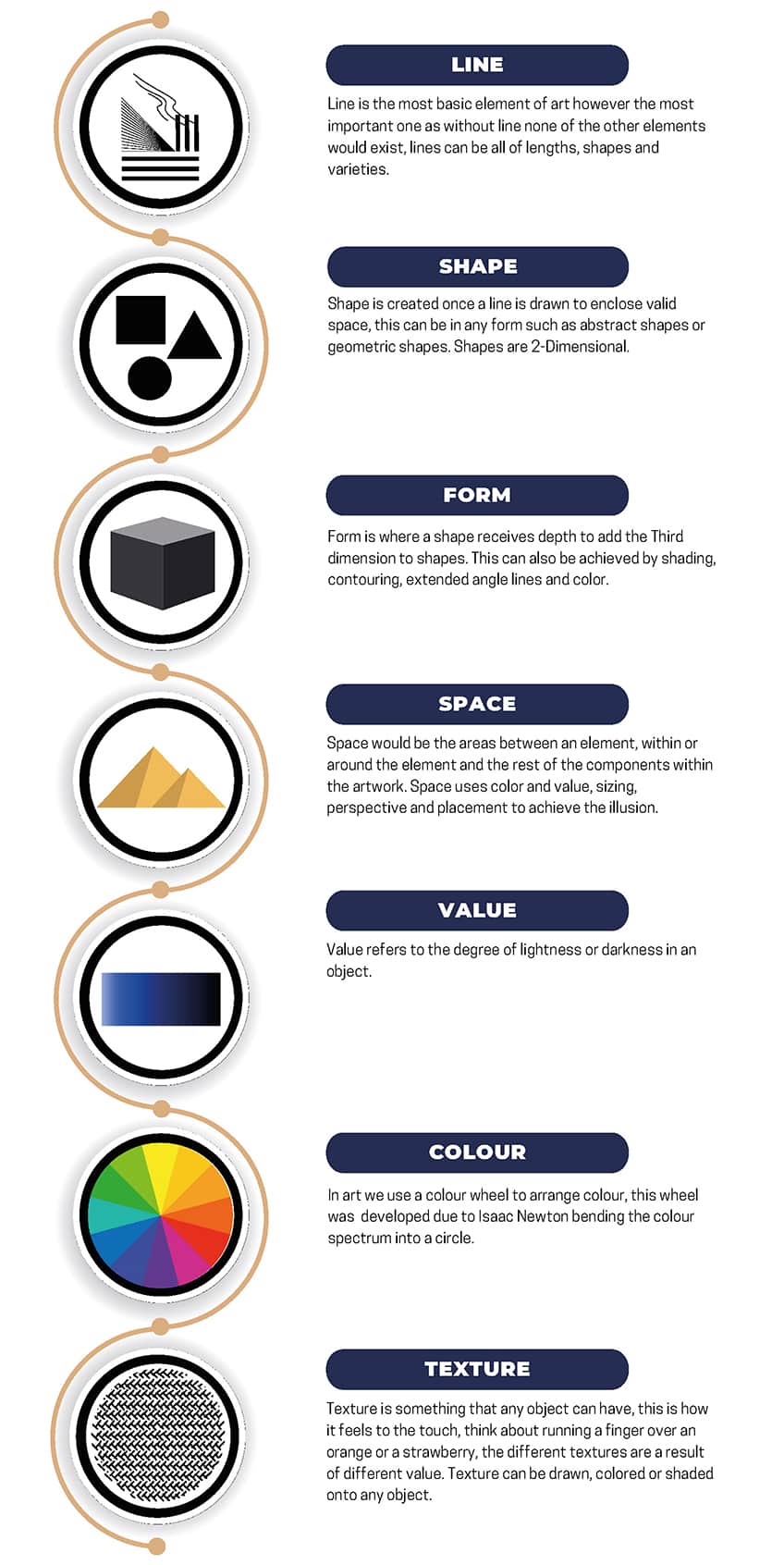
What About the Principles of Art?
Before we discuss the seven elements of art in more detail, we need to provide a brief overview of the principles of art. The principles of art are also referred to as the principles of design or the principles of organization. These principles provide structure to how the art elements are utilized and applied, and are often understood as the tools that organize them.
It is important to note that the principles of art vary according to different art sources, however, these are the most widely referred to. These include the principles of balance, contrast, emphasis, harmony, unity, proportion, rhythm, movement, variety, repetition or pattern, and scale.
Understanding the Seven Elements of Art in Detail
By understanding each art element and how they can be used to enhance and artwork’s visual impact, you can be more confident in creating works that convey themes that are important to you. Below, we will dive deeper into the seven elements of art with a detailed definition of each element and how they are applied in the visual arts.
Color is Critical
Also known as a “hue”, color is a critical art element because it reveals the main subject of the composition while guiding the viewer’s eye to important shapes and forms. Color is best understood for its role in evoking strong emotional responses. When applied strategically, color can create a well-balanced visual composition that is used to convey styles of Realism, Naturalism, and many other art approaches.
One can immediately gauge the impact of color in famous artworks such as “The Blue Horses” (1911) and “The Yellow Cow” (1911) by the German Expressionist Franz Marc.

In painting such as Marc’s The Blue Horses , one identifies the color blue in the horses, which is a traditionally unrealistic portrayal of horses. Rather, the use of blue in this case holds a deeper spiritual meaning that also alludes to Marc’s notions on masculinity, given that the symbol of the horse has been emulated as a signifier of masculinity since the modern era. In contrast to the blue hues of The Blue Horses is Marc’s use of yellow as a symbol of femininity in The Yellow Cow , which is an example of how color has been attributed to themes and concepts that have no set physicality, yet with color, can adopt new meanings.
Color Science and the Color Wheel
So, what is color? The science of color involves the process of how “visible light” is formed. To understand the importance of color, one also needs to understand the makeup of color and how we perceive it. The human eye perceives light as specifics colors, depending on its wavelength and the reception of light from cells in our eyes. This brings us to the debate around whether color is real since it is something that is perceived in the presence of light.
Of important note is also the understanding that light is only a small portion of the entire electromagnetic spectrum, and is the only form from the spectrum that the human eye can perceive.

It is important to note that there are other forms of light like ultraviolet or infrared light that we cannot see and make up part of the electromagnetic spectrum.
In total, there are seven colors visible to the human eye. These include violet, indigo, blue, green, yellow, orange, and red.
These colors are in the order of their wavelength size, which ranges from the lowest to the highest. We can better understand these colors from their various divisions, which is best summarized in the color wheel . The color wheel was invented by Sir Isaac Newton in 1666 and has since been a useful tool that organizes the different colors into three groups, namely; primary, secondary, and tertiary colors . Blue, red, and yellow are the primary colors; orange, green, and purple are secondary colors , and red-orange, red-purple, blue-purple, blue-green, yellow-green, and yellow-orange are the tertiary colors.
It is important to note that secondary colors emerge from a combination of primary colors and tertiary colors come from a combination of primary and secondary colors.
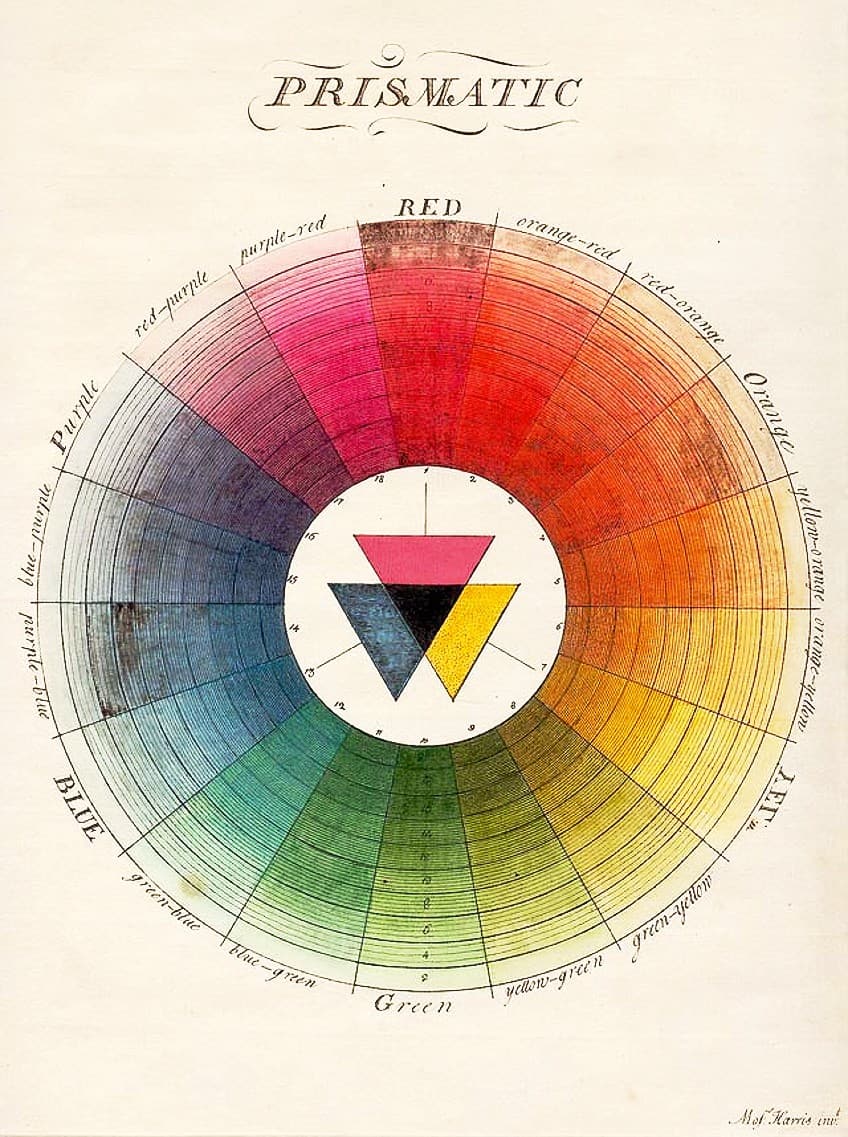
The primary colors, as noted above, produce various additional colors when combined. There are also complementary colors , which refer to the colors opposite one another on the color wheel. For example, blue is opposite orange, red is opposite green, and yellow is opposite purple. Each of these opposites are known as complementary colors.
Temperature in Color
Temperature in color refers to cool or warm colors , however, some sources suggest that this is also related to psychology and what we associate colors with. According to color science, color temperature is a measurement or scale that relates the colors of light radiated by objects to a temperature. The effect? As the temperature increases in color, so too does the emitted light, which changes toward hues that are bluer. Depending on the intensities and combinations of color, it has been suggested that some cool colors could appear warmer than others and vice versa.
If we look at colors like red or yellow, it gives us a sense of warmth and is associated with the sun or fire. Conversely, if we look at blue or green, it might give us a feeling of being cold and we could associate it with water or foliage.
Color Intensity and Saturation
Color saturation, otherwise understood as intensity, is often described as the brightness or brilliance of a hue and its level of intensity. The word “pure” is also used to describe when color is at its highest intensity because then, it is at its purest form and highly saturated.
How would you describe the opposite of a saturated color? Colors that appear dull or muted are understood as colors with low intensities.

Colors with less saturation will appear weaker or paler because of other colors like gray , white, or black added to it. Other colors can also be combined to adjust the saturation level. We will see an example of high saturation in the post-Impressionist painting titled A Meadow in the Mountains (1889) by Vincent van Gogh.
Another classic example can be seen in the work of the French Impressionist Claude Monet and his painting “Impression, Sunrise” (1872), which showcases a combination of colors with high and low saturation.
Value
Value is another important art element that can greatly impact how color is perceived. Value refers to the light or dark quality of color. Value is established when white or black is added to a color such that when white is added, it is referred to as a “tint” and black is added, it is referred to as a “shade”.
The color value can often be detected if an image is viewed in black and white to expose its grayscale values.
Furthermore, value can also create different meanings or emotional effects in an artwork by adding emphasis. Colors that are represented as darker or lighter can create various “moods” or suggest the time of day. It can also highlight part of the subject or create a focal point in the composition.
Texture is broadly defined as the surface quality of an artwork. There are two ways texture can be utilized, namely implied or real. The implied texture will give the illusion of surface quality and can range from textures that are rough, smooth, hard, or soft. Texture can also be perceived through gestural marks and two-dimensional markings. For example, photographs can have a “grainy” texture and two-dimensional drawings in graphite can emphasize different textures of objects.
Examples of texture in art was best captured by artists of the Northern Renaissance like Albrecht Dürer, who skillfully rendered his subjects with meticulous detail. This can be seen in works like “ Young Hare” (1502), where one can spot the immaculate detailing on the hare’s fine hair.
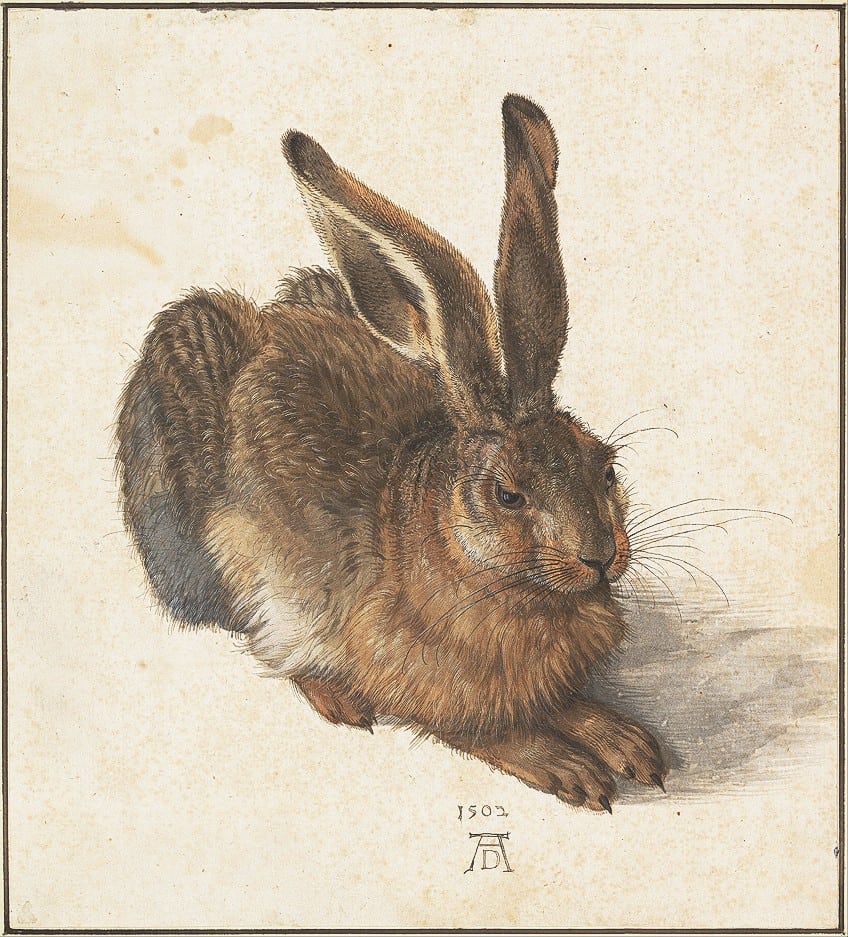
In the Dutch Golden Age, objects in still life paintings appeared almost real, which is usually described as “Realism” or “Naturalism”. An example of this style is found in Banquet Piece with Mince Pie (1635) by Willem Claesz Heda, whose application of texture is seen in the smooth and shiny surfaces of the metal objects, as well as the crumpled fabric of the tablecloth.
Real texture refers to a tactile surface, which can be either the paint on a canvas, the material of a sculpture, or an architectural structure. The Abstract Expressionist Jackson Pollock , who would physically drip or pour paint onto his canvases, is a good example of this.
In Pollock’s Autumn Rhythm (Number 30) (1950), which was created with enamel paint, we can see the tactile texture of the paint, which establishes rhythmic patterns all over the composition and is also one of the art principles we mentioned earlier.
Sculptures also provide tactile textures ranging from marble, stone, wood, plastic, or any other medium. We see this in marble sculptures like Pietà (1498 – 1499) by Michelangelo, which also implies texture as seen in Mary’s robes, which adds emphasis to the figure.
Other examples of texture in sculpture include the giant stainless steel animal sculptures created by Jeff Koons.
His famous balloon animals are larger than life and give the impression of a balloon that one would find at a birthday party. Although these sculptures have hard surfaces, they give the illusion of being as soft and fragile as an inflated balloon. An example includes Balloon Dog (Magenta) (1994 – 2000).
There are two primary types of shapes characterized by geometric and organic shapes, the latter of which is also referred to as a free form shape. Geometric shapes refer to objects like circles, squares, rectangles, or triangles and are described as two-dimensional and created by lines.
Other art elements like space and color can also contribute to creating a shape by emphasizing the negative and positive elements in the work or contributing to the color saturation and value of the subject.

Some of the best examples of geometric shapes in art are from the famous Abstract artist Piet Mondrian and the Polish-Russian painter Kazimir Malevich. Mondrian’s Composition with Yellow, Blue, and Red (1937 – 1942) depicts various squares and rectangles created by the placement of thick black lines across the canvas.
Another famous example of shape in painting can be spotted in the “Black Square” (1915) painting by Malevich, which popularized the significance of simple geometric shapes in Abstract art.
Form is another art element that relates to three dimensional structures. There are different types of forms that can range from spherical, cubic, pyramidal, conical, cylindrical, and many other types. In art, form can also be described as geometric or organic.
Form refers to the artwork’s entire framework or “body”, whether it describes the form of the subject or the physical form of a sculpture.
An example of form in art can be seen in the stainless steel Cloud Gate (2006) sculpture by Anish Kapoor in Chicago. The famous sculpture relies on an organic form, which resembles the shape of a bean shape.
The application of almost all other art elements like color, line, texture, and space can inform the outcome of the artwork’s form.
For example, with additional shading, a geometric circular shape can appear three-dimensional, thus turning into a spherical form. Techniques such as shading can also highlight an organic form. Similarly, outlines or contour lines can provide more definition to the subject.
Line is an important art element that is found in almost all types of artworks and provides the fundamental structure for the subject. Lines can vary in shape and length, from short, long, vertical, horizontal, and diagonal lines to curved, straight, thin, and thick lines.
There are numerous ways to leverage lines in a way that helps you to create different effects in an artwork.
As we mentioned earlier, art principles are tools that organize art elements. Principles like movement, rhythm, perspective, pattern, or emphasis determine how lines are utilized. If lines are applied in repeated patterns, they can create a sense of movement and rhythm giving the artwork meaning and emphasis. A famous and often-used example comes from Roy Lichtenstein’s Pop art painting In the Car (1963). The use of horizontal lines in this composition adds emphasis and creates the idea of movement and speed.
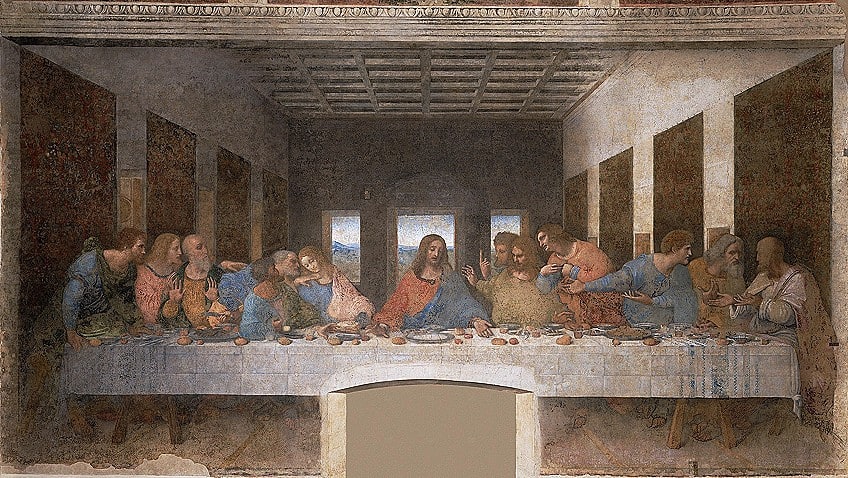
Lines can also draw attention to a focal point, for example, in Leonardo da Vinci’s The Last Supper (c. 1495 – 1498). Here, we see lines in the painted tapestries, along the left and right walls of the composition. The alignment of the tapestries creates a horizontal line that focuses our attention on the endpoint by the window in the background, which also highlights the central figure, Jesus Christ .
There are seemingly endless ways that lines can be utilized to create dramatic compositions. Whether it is through perspective methods or outlines, lines provide much room for experimentation.
Space is about the depth portrayed in a composition, which relates to its three-dimensionality. This typically refers to paintings or drawings, which depict the “illusion of space”. In sculptural or architectural art, space is defined as the area around the object, including the space occupied by the object, and whether it has openings or not.
There are also different types of space, namely positive and negative space; positive space refers to the object or subject and negative space is the space around it.
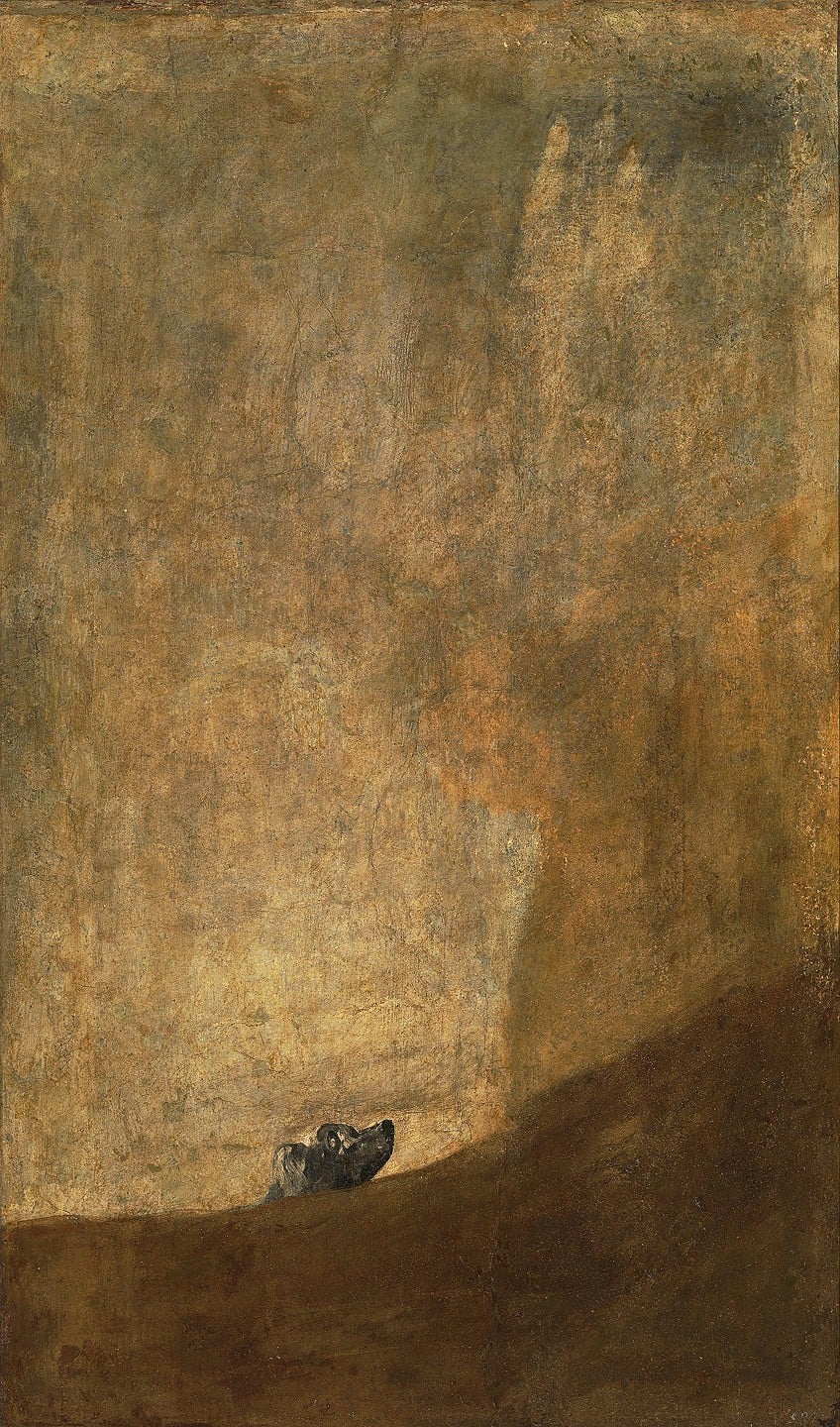
An example of this is in Francisco Goya’s Black Painting series and The Dog (c. 1819 – 1823), which features a large open space with a dog in the lower portion of the composition. This large area of space can also create emphasis and draw our attention to the dog below.
There are also techniques that assist in creating depth on a two-dimensional surface. These methods include linear and atmospheric perspectives, which employ other art elements like line, color, and value to enhance spatial effects.
In linear perspective, parallel lines that “recede” into the background to a single focal point create the illusion of space. This is what we see in Leonardo da Vinci’s The Last Supper (c. 1495 to 1498) mentioned above. Atmospheric perspective involves the use of color and value to create a hazy effect of the subject in the distance of a composition. By strategically applying space where necessary, you can be confident that your artwork will carry a great visual impact.
With these seven art elements in mind, your art practice is sure to improve. There is always more than meets the eye in any artwork and by understanding how art elements are utilized strategically, will also enhance your analytical capabilities.
Take a look at our art elements webstory here!
Frequently Asked Questions
What are the elements of art.
The elements of art include color, value, texture, line, shape, form, and space that can be used to create harmonious works of art. These art elements can also be used to analyze paintings, drawings, sculptures, graphic art, or any other type of art. Art elements are used to enhance an artwork, establish the subject, convey emotions, and guide the viewer’s eye to the main aspects of a composition.
How Many Art Elements Are There?
There are typically seven elements of art. These include value, color, space, texture, line, form, and shape, and are recognized as the most common art elements, among many sources and scholars. The seven elements of art are used in conjunction with the principles of art to create impactful works of art.
Why Are the Elements of Art Important?
The elements of art are incredibly important to enhance the impact of your artwork. Artists should learn more about the art elements and how to use them to not only create more visually impactful art but to critique it. Most importantly, one cannot create art without using even a few elements combined to depict, represent, and convey the message, image, or concept behind the artwork.

Alicia du Plessis is a multidisciplinary writer. She completed her Bachelor of Arts degree, majoring in Art History and Classical Civilization, as well as two Honors, namely, in Art History and Education and Development, at the University of KwaZulu-Natal, South Africa. For her main Honors project in Art History, she explored perceptions of the San Bushmen’s identity and the concept of the “Other”. She has also looked at the use of photography in art and how it has been used to portray people’s lives.
Alicia’s other areas of interest in Art History include the process of writing about Art History and how to analyze paintings. Some of her favorite art movements include Impressionism and German Expressionism. She is yet to complete her Masters in Art History (she would like to do this abroad in Europe) having given it some time to first develop more professional experience with the interest to one day lecture it too.
Alicia has been working for artincontext.com since 2021 as an author and art history expert. She has specialized in painting analysis and is covering most of our painting analysis.
Learn more about Alicia du Plessis and the Art in Context Team .
Cite this Article
Alicia, du Plessis, “Elements of Art – An Analysis of the Seven Art Elements.” Art in Context. July 1, 2022. URL: https://artincontext.org/elements-of-art/
du Plessis, A. (2022, 1 July). Elements of Art – An Analysis of the Seven Art Elements. Art in Context. https://artincontext.org/elements-of-art/
du Plessis, Alicia. “Elements of Art – An Analysis of the Seven Art Elements.” Art in Context , July 1, 2022. https://artincontext.org/elements-of-art/ .
Similar Posts

Chicano Art – Discover the Mexican American Art of Chicano Painters
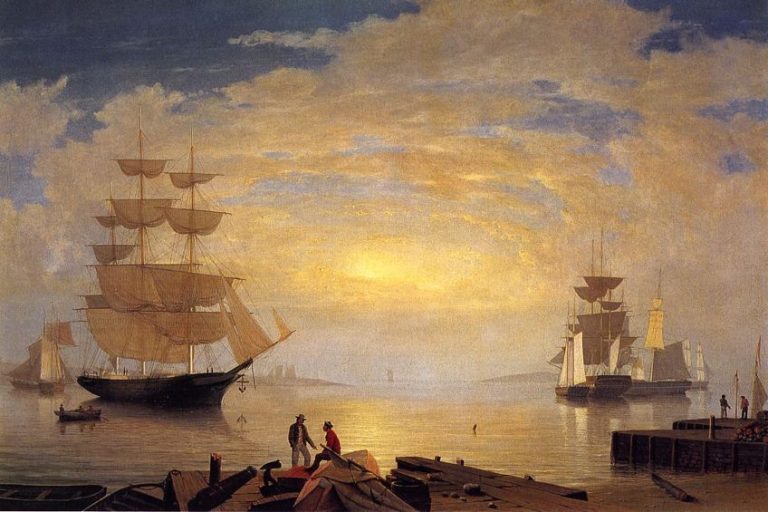
Luminism – A Captivating Moment in American Art
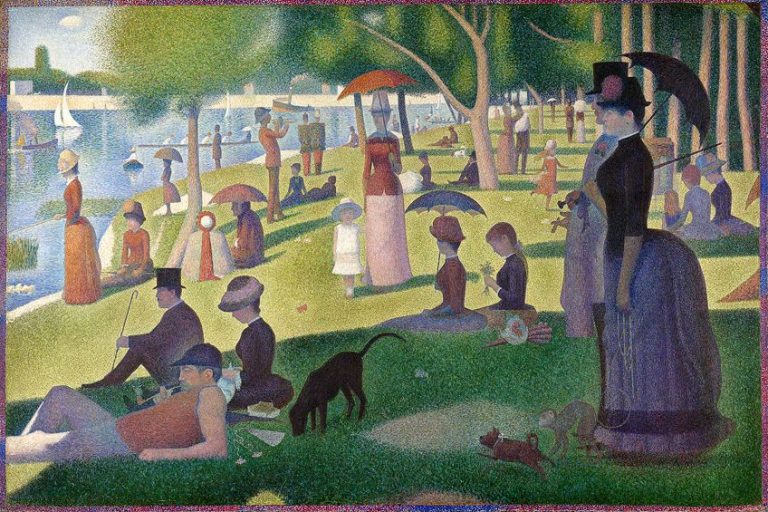
Pointillism – The Neo-Impressionist Dot Painting Technique
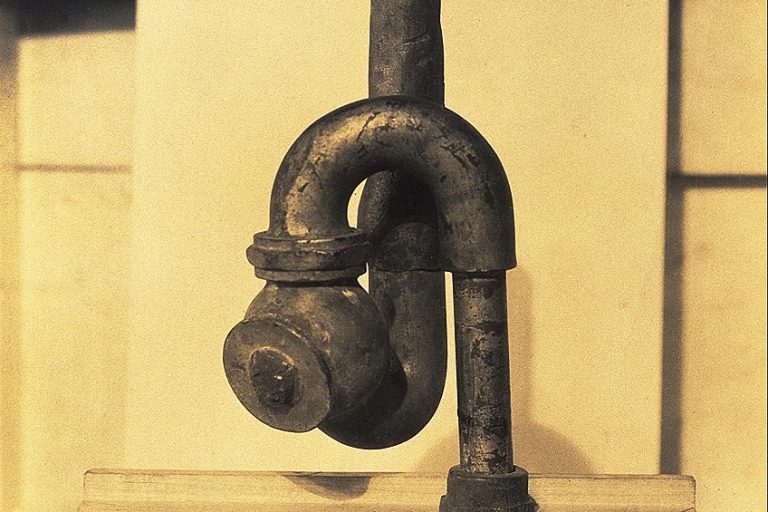
Readymade Art – The Legacy of Repurposed Art
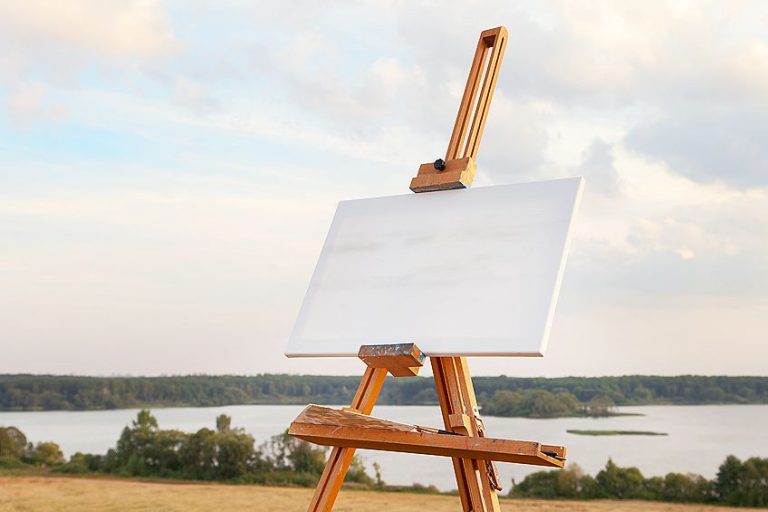
Plein Air Painting – A Detailed History of Open Air Painting

Kitsch Art – A Look at Famous Kitsch Paintings and Artworks
Thank you for this informative post. I thought of my dear art teacher Mrs. Evelyn Frankel; the very best teacher.
Thank you for your kind feedback, Louis.
Leave a Reply Cancel reply
Your email address will not be published. Required fields are marked *
Save my name, email, and website in this browser for the next time I comment.
The Most Famous Artists and Artworks
Discover the most famous artists, paintings, sculptors…in all of history!

MOST FAMOUS ARTISTS AND ARTWORKS
Discover the most famous artists, paintings, sculptors!

ELEMENTS OF ART – OUR NEW EBOOK !

In-depth knowledge of the elements of art in 8 chapters and 125 pages, for enthusiasts, practicing artists, and students.
Now with Discount!
The 7 Elements of Art and Why Knowing Them Is Important
ThoughtCo / Marina Li
- Art History
- Architecture
The elements of art are sort of like atoms in that both serve as "building blocks" for creating something. You know that atoms combine and form other things. Sometimes they'll casually make a simple molecule, as when hydrogen and oxygen form water (H 2 O). If hydrogen and oxygen take a more aggressive career path and bring carbon along as a co-worker, together they might form something more complex, like a molecule of sucrose (C 12 H 22 O 11 ).
The 7 Elements of Art
A similar activity happens when the elements of art are combined. Instead of elements such as hydrogen, oxygen, carbon, in art you have these building blocks:
Artists manipulate these seven elements, mix them in with principles of design, and compose a piece of art. Not every work of art contains every one of these elements, but at least two are always present.
For example, a sculptor, by default, has to have both form and space in a sculpture, because these elements are three-dimensional. They can also be made to appear in two-dimensional works through the use of perspective and shading.
Art would be sunk without line, sometimes known as "a moving point." While line isn't something found in nature, it is absolutely essential as a concept to depicting objects and symbols, and defining shapes.
Texture is another element, like form or space, that can be real (run your fingers over an Oriental rug, or hold an unglazed pot), created (think of van Gogh's lumpy, impasto-ed canvases) or implied (through clever use of shading).
Color is often the whole point for people who are visual learners and thinkers.
Why Are the Elements of Art Important?
The elements of art are important for several reasons. First, and most importantly, a person can't create art without utilizing at least a few of them. No elements, no art—end of story. And we wouldn't even be talking about any of this, would we?
Secondly, knowing what the elements of art are enables us to:
- describe what an artist has done
- analyze what is going on in a particular piece
- communicate our thoughts and findings using a common language
Musicians can talk about the key of "A," and they all know it means "a pitch relating to 440 oscillations per second of vibration." Mathematicians may use the very basic word "algorithm" and feel confident that most people know they mean "a step-by-step procedure for carrying out computation." Botanists world-wide will employ the name "rosa rugosa," rather than the much longer "that old-fashioned shrub rose - you know, the one that leaves hips in the fall - with the five-petaled flowers that can be yellow, white, red or pink." These are all specific examples of a common language coming in handy for intelligent (and shortened) discourse.
So it is with the elements of art. Once you know what the elements are, you can trot them out, time after time, and never put a wrong foot forward in the art world.
Does your instructor want you to write a few words and/or pages on a painting of your choice? Choose wisely, and then wax euphoric on form, lines, and color.
Have you found an unidentified work in your great-aunt's attic/toolshed/outhouse? It is helpful when describing the piece to someone who may be able to supply you with further information, to throw in some of the piece's elements of art along with: "It's an etching. It's on paper."
Stumped for conversation at a gallery show? Try "The artist's use of ________ (insert element here) is interesting." This is a much safer course than attempting to psychoanalyze the artist (after all, you may be standing in a clump of people that includes his or her mother) or using words which leave you a bit uncertain of exact meanings and/or pronunciations.
The elements of art are both fun and useful. Remember line, shape, form, space, texture, value and color. Knowing these elements will allow you to analyze, appreciate, write and chat about art, as well as being of help should you create art yourself.
- The 7 Principles of Art and Design
- The 8 Elements of Composition in Art
- The Element of Space in Artistic Media
- What Is Meant by "Emphasis" in Art?
- Art History 101: A Brisk Walk Through the Art Eras
- The Collage Art of Photomontage
- The Heartfelt Art of Jim Dine
- The Most Important Functions of Art
- Painting Exhibition: Vincent van Gogh and Expressionism
- How Value Is Defined in Art
- What Is Meant by Impasto in Art?
- What Is the Definition of 'Medium' in Art?
- What Is the Atomic Number?
- What Are the Elements in the Human Body?
- Impressionism Art Movement: Major Works and Artists

Elements of Art
So how many elements are there? My art teacher claims there’s seven but I’ve read online there’s only 5 elements. What’s going on here?
Note: The elements of art and the elements of design are the same thing. Each phrase is synonymous with one another. As an art student or art teacher you’ll probably come across both terms. In this post we’ll mostly be defining them as the “elements of art”. Once in a while I might use the term “elements of design” just for variety!
Elements of Art = Elements of Design = Design Elements (all synonyms)
How Many Art Elements Are There?
That really depends on who you ask. Most art education textbooks and therefor art teachers work from a list of 7 elements. If you look them up on the internet you’ll often encounter only 5.
Whether 7 or 5 each list contains the same items, they are just organized differently to include sub-components.
For example…
Shape & Form are considered close enough as a visual concept to be included together in the case for five elements of art. Also, value is really a part of color and should be listed as a sub-component of color and not constitute a main element on its own. The following is the most common lists of art elements you’ll encounter.
By the way, we’ll be describing each element in greater depth and each definition will be accompanied by multiple photo references.
7 Elements of Art
5 elements of art.
- Shape & Form
Now that you’re acquainted with the seven and five art elements I’d like to propose another approach.
A Case for 4 Art Elements!
I’d like to propose a new idea. In the spirit of building a pure hierarchy that makes logical sense. There really only needs to be 4 elements of art. That’s right…I said four! Hear me out and I’ll show you reasons why the most common art elements lists are illogical (especially the 7 elements listed above)…
Shape and form should really be considered a sub-component of space .
- Shape is a two-dimensionally enclosed space .
- Form is the three-dimensional space that an object occupies.
You see? Whether 2D or 3D, occupied or empty, space is really just space.
How about another area for improvement?
Value is one of the three properties of color so listing it as its own art element is silly.
My Proposal for 4 Elements of Art and their breakdown looks like this:
4 Elements of Art
Now folks, that is about as logical as it gets. Will I convince the rest of the art world to adopt this hierarchy? Doubtful, but at least I tried. If I can get a few minds thinking rationally then it’s been worth it!
( I was tempted to include line in the space category because line is really just a one-dimensional space, but that’s more of a mathematical definition, rather than an art definition.)
Okay… I’ve put my 2 cents in so let’s get to the good stuff…
What Are These Elements (and what makes them so special)?
Art can often be very confusing to students looking to learn how to draw, paint or even sculpt. There’s so many vocabulary words used inconsistently by various art professionals and instructors alike.
The Elements of Design are a way to instill a little bit of commonality between all forms of visual art. Whether that is two-dimensional art or three-dimensional art forms. These basic components of art allow us to describe a work of art in a more precise way.
Think of these art elements as the visual building blocks for all visual art forms.
Think about that for a moment… Anytime you are creating something you are using one, if not many of the elements.
Getting Started: A Few Simple Examples
Before we start defining them individually let’s run through a quick example to demonstrate what I mean:
If you were to start drawing you would immediately be working with line . Once you start to shade in your drawing your end up with value .

Want a quick 3-D example? Try this… If you were to throw a vase on a potter’s wheel you are working with form and the clay body has a certain texture to it.

Now that you have a small understanding of how the elements of visual art are used in everyday art we can dive deeper into each element’s definition.
Making Informed Observations
It’s important to remember that the elements of design (art) are seldom used in isolation. They often work together in a drawing, painting or any other type of art. In fact many of the elements cannot exist without one another. For example, you’ll never notice a shape unless it is outlined or is filled in solid with a different color.
Defining the Elements of Art
Don’t forget, the elements are nothing more than the visual building blocks for art-making.
If art was cooking the elements of art would be the ingredients!
Element of Art: Line
A line is a continuous mark made on a surface defined by a point moving through space. A line is an discernible path that divides up the artwork’s space in some fashion.
Lines can have many properties. As a simple entity, line has width, length, and direction. Sometimes a line’s thickness is referred to as its “stroke” especially in computer programs aimed at drawing and photo editing.

In a mathematical sense a line is one-dimensional. If anything was truly one-dimensional in a piece of art you wouldn’t be able to see it. So really, when we investigate it further lines must contain a small amount of width in order for us to actually see them.

Besides the most obvious properties just discussed, lines can exhibit more complicated and interesting qualities. They can be curved, straight, horizontal, vertical or diagonal. Lines can also be thick, thin or of variable thickness. And still yet lines can be continuous or broken.

Some of the most interesting use of line comes from its implied use. Certain aspects in a work of art can “lead” the view’s eye along a path.

Element of Art: Shape
S ee Sp a ce: Sha pe
Element of Art: Form
See Space: Form
Element of Art: Color
Color is what you see when looking at objects under light. It’s your brain’s mental image or response to certain wavelengths of light reflected off the objects around you.
Even though there is a science to color, what you are seeing is really all made up in your own mind. However, what’s made up is a direct response to the reality before you. This reality being the rays of “light” striking an object’s surface and bouncing off that surface and finally striking your eye. Here, light is actually the electromagnetic radiation in the visible light spectrum.
There are 3 properties that make up a color.
Just to be clear there a many synonyms for these terms. Saturation is also referred to as “intensity” or “chroma”. Value is sometimes referred to as “lightness”, “brightness” or even “tone”. If you’re interested in art you really should get familiar with color’s three properties. Let’s briefly outline each property and look at some examples.
A color’s hue defines where that color exists on the color wheel. Hue is what gives color its name. For example: something that appears blue is from the blue area of the color spectrum. Remember, the color wheel is nothing more than the color spectrum formed into a circle.

A color’s hue is a direct result of the wavelength(s) of light reflecting off an object’s surface. Certain materials (different pigments) reflect/favor specific ranges of visible light and our brain informs us of these changes by allowing us to see things as different hues!
Color: Value
Value describes the brightness of color. Value is a measurement of how light or dark a color is. To understand a color’s value it is helpful to remove saturation and hue. You can observe a color’s value by taking a photograph and converting the photograph to a grayscale image.

Color: Saturation
The saturation of a color is a measure of how pure or vivid a color is. Also referred to as a color’s intensity or chroma ( Munsell system of color ), saturation describes just how dull a color is. When a color appears dull and grayish it is a color with low saturation . When a color is vivid looking you are seeing a color that is saturated.

The image below demonstrates how colors can have different saturations. Both The yellow ochre (on the left) and the Cadmium Yellow Light (on the right) are yellow hues but where they contrast greatly is in their saturation levels. The Cadmium Yellow is much more saturated than the Yellow Ochre.

Color Changes: Some Final Observations
Once you gain an understanding of color, especially through pigment mixing in a medium such as painting, you’ll soon realize that hue, value, and saturation are intimately related. Each color component although defined independent of one another has a direct influence upon each other.
Once you alter one component of color you’ll find that you have also altered another.
Let’s illustrate this principle by looking at a simple example involving paint. If you have red paint on your palette and lighten it up with white you would be changing the red’s value. But, you are at the same time reducing the red paint’s saturation. Remember a color’s saturation is a measure of its purity. Red + White = less than 100% red!
To illustrate this point using a different color, take a look below at this paint string I mixed up using Raw Umber and Titanium White. It shows what happens when you mix a warm, low-saturation color with titanium white. Moving across the swatches from left to right you can see the value getting lighter as expected. But you can also observe the raw umber getting grayer and greener.

Raw umber which is a very low-saturation yellow starts to turn grayish-green when you add titanium white to it.
This is because titanium white is not actually pure white. Although titanium dioxide, the pigment used to make most modern white paints IS the brightest white available it favors the cooler side of the spectrum. Yep, it’s nothing more than a really, really, really, light blue-ish color. That’s why you get greenish colors when you mix yellow colors with titanium white. Or you get neutral colors when working with oranges!

Element of Art: Value
See Element of Art: Color: Value
It’s redundant to list value as its own element of art because value is a subcomponent of color. You will find, however, that most art books and therefor art teachers include value as its own element of art.
To demonstrate how silly their logic is let’s use a simple example:
Take a look at how scientists classify vertebrates from the animal kingdom. We have: Amphibians, reptiles, birds, mammals, etc… We don’t suddenly give frogs their own class (Frogs are a sub-group of amphibians). That would be ridiculous wouldn’t it?
If we were classifying styles of homes we could start generating a list of categories like: tudor, colonial, ranch, cape cod, etc. We wouldn’t add “bedroom” to this list of categories would we? Yet that is precisely what we are doing when we include color AND value as their own distinct art elements.
Element of Art: Space
Space is the element of art that refers to the area between, around, or within things. Space can be 2D or 3D. Space is everywhere and is sometimes even forgotten. A chair in a room occupies a certain three-dimensional space but the “empty” space around the chair is also a space.
Space: Shape
A shape can be defined as a two-dimensionally enclosed space. Shape is defined by other visual elements of design such as line, color, or texture. Shape is flat and contains height and width but no depth.
Shapes can be either geometric or organic .

Geometric Shapes
Geometric shapes are 2D spaces that are very precise and mechanical looking. Examples of geometric shapes are circles, rectangles, triangles, or any polygon really.
When drawing geometric shapes you’ll typically be using some kind of tool such as a straight edge or compass.
We can see geometric shapes throughout most of the architecture we see around us.
Organic Shapes
Organic shapes are 2D spaces that are more free-form in their appearance. Unlike a geometric shape, an organic shape looks more hand-drawn and less precise.
It comes as no surprise that you’ll find tons of organic shapes throughout nature. Nature is rarely made up of perfectly straight lines and precisely calculated angles.
Space: Form

Three-dimensional forms can be seen from more than one side, such as this sculpture I saw on the Charles Bridge in Prague, Czech Republic. I thought it was interesting how the sculptor included a curious dog in the sculpture. (You can see the dog peering, curiously into the gated arch).
It’s important to note that in the disciplines of two-dimensional art such as drawing and painting, form is implied and nothing more than an illusion. When we describe the “form” in a drawing we are really describing the illusion of form. This is the case because a drawing is flat.
Positive & Negative Space
You can’t go for very long in the field of art without hearing about positive and negative space. But what are they?
Positive Space is the space occupied by any element or subject matter while Negative Space is the space around the positive space. Please note that both negative and positive space can be 2D or 3D. They are also subject to the element being referenced.

Often when describing the large-scale space created by artwork (usually illusiory space in drawings and paintings) we refer to the various distances as “grounds”. Grounds are the groups of items that appear to be at similar distances in the work of art. While artwork can have unlimited amounts of grounds the three most common terms you’ll hear discussed are:
- Foreground : The area(s) closest to the viewer.
- Middle Ground : The area(s) in between the foreground and the background.
- Background : The area(s) farthest away from the viewer.

Element of Art: Texture
Texture in art is its surface quality in whole or part of. Texture describes how something feels when touched or in the case of most 2D works how something would appear to feel. As a result, texture can be actual or implied (simulated) .

Art teachers love to teach the elements of art. The elements have been a nice way to apply a small amount of standardization in a field that can otherwise be really difficult to quantify.
Art is not as finite as math. Well actually, one can exhibit creativity within mathematics and artists can be very mathematical and logical in their own right. But, that’s another topic for another time.
The point is, you’re likely to encounter the elements of art in one form or another if you are involved in drawing, painting, design, sculpture or any visually creative field in any academic sense. Knowing the elements of art won’t instantly make you a better artist. They are simply a means of identifying some visual aspects of artwork.
Familiarity with the elements of art will help you break-down artwork into simpler to understand components and understand how the artwork is made. So that’s definitely a step in the right direction if you’re looking to increase your artistic awareness.
The Visual Experience 3 rd Ed. Hobbs, Salome, Vieth Davis Publications
Exploring Painting 3 rd Ed. Brommers & Kinne Davis Publications
Exploring Visual Design 3 rd Ed. Gatto, Porter, Selleck
https://en.wikipedia.org/wiki/Elements_of_art
http://www.gutenberg.org/ebooks/25290
http://www.getty.edu/education/teachers/building_lessons/formal_analysis.html
As an art teacher with a month-by-month curriculum to follow, this has been something that has frustrated me immensely… I fully agree with you… not to mention, 4 elements is MUCH easier for kids to remember… PLUS it divides the year much easier… instead, it seems my block is so rushed trying to fit more like 11-ish elements of art / principles of design in… (it includes composition, balance, symmetry, pattern, etc.) which personally, I feel should be dispersed fairly evenly and be introduced and built upon within each lesson plan…. however, looking at the pacing guide… apparently I should be teaching composition and balance at the end of the year… but how can I go 6 months without discussing how to COMPOSE an artwork?!
Unfortunately most academic stuff is devised by means of “group think” and as a result we get a lot of unorganized, nonsense.
Leave a Reply Cancel reply
Your email address will not be published. Required fields are marked *

- school Campus Bookshelves
- menu_book Bookshelves
- perm_media Learning Objects
- login Login
- how_to_reg Request Instructor Account
- hub Instructor Commons
- Download Page (PDF)
- Download Full Book (PDF)
- Periodic Table
- Physics Constants
- Scientific Calculator
- Reference & Cite
- Tools expand_more
- Readability
selected template will load here
This action is not available.

1.5.2: Formal or Critical Analysis of Art
- Last updated
- Save as PDF
- Page ID 156840

- Pamela Sachant, Peggy Blood, Jeffery LeMieux, & Rita Tekippe
- University System of Georgia via GALILEO Open Learning Materials
While restricting our attention only to a description of the formal elements of an artwork may at first seem limited or even tedious, a careful and methodical examination of the physical components of an artwork is an important first step in “decoding” its meaning. It is useful, therefore, to begin at the beginning. There are four aspects of a formal analysis: description, analysis, interpretation, and evaluation . In addition to defining these terms, we will look at examples.
Description
- What can we notice at first glance about a work of art? Is it two-dimensional or three-dimensional? What is the medium? What kinds of actions were required in its production? How big is the work? What are the elements of design used within it?
- Starting with line: is it soft or hard, jagged or straight, expressive or mechanical? How is line being used to describe space?
- Considering shape: are the shapes large or small, hard-edged or soft? What is the relationship between shapes? Do they compete with one another for prominence? What shapes are in front? Which ones fade into the background?
- Indicating mass and volume: if two-dimensional, what means if any are used to give the illusion that the presented forms have weight and occupy space? If three-dimensional, what space is occupied or filled by the work? What is the mass of the work?
- Organizing space: does the artist use perspective? If so, what kind? If the work uses linear perspective, where are the horizon line and vanishing point(s) located?
- On texture: how is texture being used? Is it actual or implied texture?
- In terms of color: what kinds of colors are used? Is there a color scheme? Is the image overall light, medium, or dark?
- Once the elements of the artwork have been identified, next come questions of how these elements are related. How are the elements arranged? In other words, how have principles of design been employed?
- What elements in the work were used to create unity and provide variety? How have the elements been used to do so?
- What is the scale of the work? Is it larger or smaller than what it represents (if it does depict someone or something)? Are the elements within the work in proportion to one another?
- Is the work symmetrically or asymmetrically balanced?
- What is used within the artwork to create emphasis? Where are the areas of emphasis? How has the movement been conveyed in the work, for example, through line or placement of figures?
- Are there any elements within the work that create rhythm? Are any shapes or colors repeated?
Interpretation
- Interpretation comes as much from the individual viewer as it does from the artwork. It derives from the intersection of what an object symbolizes to the artist and what it means to the viewer. It also often records how the meaning of objects has been changed by time and culture.
- Interpretation, then, is a process of unfolding. A work that may seem to mean one thing on first inspection may come to mean something more when studied further. Just as when re-reading a favorite book or re-watching a favorite movie, we often notice things not seen on the first viewing; interpretations of art objects can also reveal themselves slowly.
- Claims about meaning can be made, but are better when they are backed up with supporting evidence. Interpretations can also change and some interpretations are better than others.
- All this work of description, analysis, and interpretation, is done with one goal in mind: to make an evaluation about a work of art.
- Just as interpretations vary, so do evaluations. Your evaluation includes what you have discovered about the work during your examination as well as what you have learned, about the work, yourself, and others in the process.
- Your reaction to the artwork is an important component of your evaluation: what do you feel when you look at it? And, do you like the work? How and why do you find it visually pleasing, in some way disturbing, and emotionally engaging?
Examples of Formal Analysis
Snow Storm—Steam-Boat off a Harbour’s Mouth by J. M. W. Turner
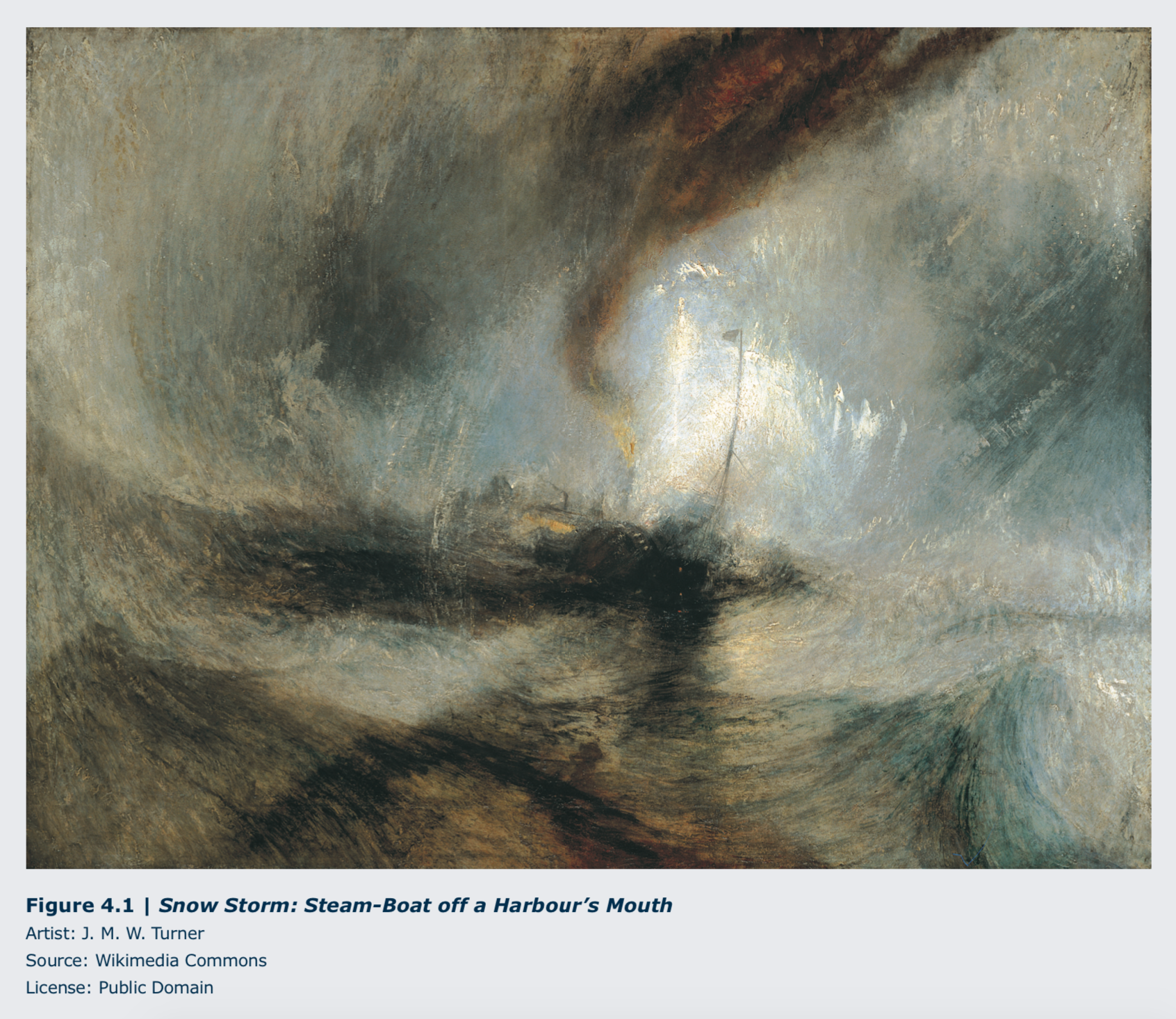
- First, on the level of description , the dark structure of the foundering steamboat is hinted at in the center of the work, while heavy smoke from the vessel, pitching waves, and swirling snow surround it.
- The brown and gray curving lines are created with long strokes of heavily applied paint that expand to the edges of the composition.
- Second, we note that the paint application, heavy, with long strokes, adds dramatic movement to the image. We see that the design principle of scale and proportion is being used in the small size of the steamboat in relation to the overall canvas.
- Now let us interpret these elements and their relation: The artist has emphasized the maelstrom of sea, snow, and wind. A glimpse of blue sky through the smoke and snow above the vessel is the only indication of space beyond this gripping scene of danger, and provides the only place for the viewer’s eyes to rest from the tumult. This scene is humanity’s struggle for survival against powerful forces of nature.
- And finally, we are ready to evaluate this work. Is it powerfully effective in reminding us of the transitory nature of our own limited existence, a memento morii, perhaps? Or is it a wise caution of the limits of our human power to control our destiny? Does the work have sufficient power and value to be accepted by us as significant? The verdict of history tells us it is. J.M.W. Turner is considered a significant artist of his time, and this work is one that is thought to support that verdict.
- In the end, however, each of us can accept or reject this historical verdict for our own reasons. We may fear the sea. We may reject the use of technology as valiantly heroic. We may see the British colonial period as one of oppression and tyranny and this work as an illustration of the hubris of that time. Whatever we conclude, this work of art stands as a catalyst for this important dialogue.
Lady at the Tea Table- Mary Cassatt Mary Cassatt

Another example of formal analysis. Consider Lady at the Tea Table by Mary Cassatt Mary Cassatt (1844-1925, USA, lived France) is best known for her paintings, drawings, and prints of mothers and children. In those works, she focused on the bond between them as well as the strength and dignity of women within the predominantly domestic and maternal roles they played in the nineteenth century.
- Lady at the Tea Table is a depiction of a woman in a later period of her life, and captures the sense of calm power a matriarch held within the home. (Figure 4.2)
- First, a description of the elements being used in this work: The white of the wall behind the woman and the tablecloth before her provide a strong contrast to the black of her clothing and the blue of the tea set.
- The gold frame of the artwork on the wall, the gold rings on her fingers, and the gold bands on the china link those three main elements of the painting.
- Analysis shows the organizing principle of variety is employed in the rectangles behind the woman’s head and the multiple circles and arcs of the individual pieces of the tea set. The composition is a stable triangle formed by the woman’s head and body, and extending to the pieces of china that span the foreground from one edge of the composition to the other.
- Let us interpret these observations. There is little evidence of movement in the work other than the suggestion that the woman’s hand, resting on the handle of the teapot, may soon move. Her gaze, directed away from the viewer and out of the picture frame, implies she is in the midst of pouring tea, but her stillness suggests she is lost in thought. How to evaluate this work? The artist expresses a restrained but powerful strength of character in her treatment of this subject. Is the lack of obvious movement in the work a comment on the emergence of women’s roles in society, a hope or a demand for change? Or is it a monument to the quiet dignity of the domestic life of Victorian era Paris? The gold of the frame, the rings, and the china dishes appear to unify three disparate objects into one statement of value. Do they symbolize art, fidelity, and service? Is this a comment on the restrictions of French domestic society, or a claim to its strength? One indication of the quality of a work of art is its power to evoke multiple interpretations. This open and poetic richness is one reason why the work of Mary Cassatt is considered to be important.
Following are examples on how to include the visual elements of art and principles of design while doing a formal analysis (a critique) on a work of art. (The visual elements of art and principles of design will be discussed in Chapters 2 and 3.)
Let's start by dissecting the visual elements of art.

Vincent Van Gogh, The Bedroom, 1889. Oil on canvas, 28¾ x 36¼”. " Van Gogh, The Bedroom " by profzucker is licensed under CC BY-NC-SA 2.0 .
When analyzing, remember elements of art: Line, Shape, Color, Space and Texture.
Now you are seeing it differently. You put attention to detail. You can see through these five different possibilities by reading this artwork.
Let's put it all together. Following is an example on how to include the visual elements of art and principles of design while doing a formal analysis (a critique) on a work of art.
How to do visual (formal) analysis in art history. (2017, September 18), uploaded by SmartHistory. https://youtu.be/sM2MOyonDsY
Speakers: Dr. Steven Zucker and Dr. Beth Harris
DeWitte, Debra J. , Larmann, Ralph M. , and Shields, M. Kathryn Gateways to Art: Understanding the Visual Arts Third Edition. Copyright © 2015 Thames & Hudson
Toledo Museum of Art. The Art of Seeing Art. www.toledomuseum.org
Essay on Art
500 words essay on art.
Each morning we see the sunshine outside and relax while some draw it to feel relaxed. Thus, you see that art is everywhere and anywhere if we look closely. In other words, everything in life is artwork. The essay on art will help us go through the importance of art and its meaning for a better understanding.

What is Art?
For as long as humanity has existed, art has been part of our lives. For many years, people have been creating and enjoying art. It expresses emotions or expression of life. It is one such creation that enables interpretation of any kind.
It is a skill that applies to music, painting, poetry, dance and more. Moreover, nature is no less than art. For instance, if nature creates something unique, it is also art. Artists use their artwork for passing along their feelings.
Thus, art and artists bring value to society and have been doing so throughout history. Art gives us an innovative way to view the world or society around us. Most important thing is that it lets us interpret it on our own individual experiences and associations.
Art is similar to live which has many definitions and examples. What is constant is that art is not perfect or does not revolve around perfection. It is something that continues growing and developing to express emotions, thoughts and human capacities.
Importance of Art
Art comes in many different forms which include audios, visuals and more. Audios comprise songs, music, poems and more whereas visuals include painting, photography, movies and more.
You will notice that we consume a lot of audio art in the form of music, songs and more. It is because they help us to relax our mind. Moreover, it also has the ability to change our mood and brighten it up.
After that, it also motivates us and strengthens our emotions. Poetries are audio arts that help the author express their feelings in writings. We also have music that requires musical instruments to create a piece of art.
Other than that, visual arts help artists communicate with the viewer. It also allows the viewer to interpret the art in their own way. Thus, it invokes a variety of emotions among us. Thus, you see how essential art is for humankind.
Without art, the world would be a dull place. Take the recent pandemic, for example, it was not the sports or news which kept us entertained but the artists. Their work of arts in the form of shows, songs, music and more added meaning to our boring lives.
Therefore, art adds happiness and colours to our lives and save us from the boring monotony of daily life.
Get the huge list of more than 500 Essay Topics and Ideas
Conclusion of the Essay on Art
All in all, art is universal and can be found everywhere. It is not only for people who exercise work art but for those who consume it. If there were no art, we wouldn’t have been able to see the beauty in things. In other words, art helps us feel relaxed and forget about our problems.
FAQ of Essay on Art
Question 1: How can art help us?
Answer 1: Art can help us in a lot of ways. It can stimulate the release of dopamine in your bodies. This will in turn lower the feelings of depression and increase the feeling of confidence. Moreover, it makes us feel better about ourselves.
Question 2: What is the importance of art?
Answer 2: Art is essential as it covers all the developmental domains in child development. Moreover, it helps in physical development and enhancing gross and motor skills. For example, playing with dough can fine-tune your muscle control in your fingers.
Customize your course in 30 seconds
Which class are you in.

- Travelling Essay
- Picnic Essay
- Our Country Essay
- My Parents Essay
- Essay on Favourite Personality
- Essay on Memorable Day of My Life
- Essay on Knowledge is Power
- Essay on Gurpurab
- Essay on My Favourite Season
- Essay on Types of Sports
Leave a Reply Cancel reply
Your email address will not be published. Required fields are marked *
Download the App

Visual Analysis: How to Analyze a Painting and Write an Essay

A visual analysis essay is an entry-level essay sometimes taught in high school and early university courses. Both communications and art history students use visual analysis to understand art and other visual messages. In our article, we will define the term and give an in-depth guide on how to look at a piece of art and write a visual analysis essay. Stay tuned until the end for a handy visual analysis essay example from our graduate paper writing service .
What Is Visual Analysis?
Visual analysis is the process of looking at a piece of visual art (painting, photography, film, etc.) and dissecting it for the artist’s intended meaning and means of execution. In some cases, works are also analyzed for historical significance and their impact on culture, art, politics, and the social consciousness of the time. This article will teach you how to perform a formal analysis of art.
Need Help With Your Visual Analysis?
You only need to send your paper requirements to get help from professional writers.
A visual analysis essay is a type of essay written mostly by students majoring in Art History and Communications. The process of visual analysis can be applied to painting, visual art, journalism, photo-journalism, photography, film, and writing. Works in these mediums are often meant to be consumed for entertainment or informative purposes. Visual analysis goes beyond that, focusing on form, themes, execution, and the compositional elements that make up the work.
Classical paintings are a common topic for a visual analysis essay because of their depth and historical significance. Take the famous Raphael painting Transfiguration. At first glance, it is an attractive image showing a famous scene from the Bible. But a more in-depth look reveals practical painting techniques, relationships between figures, heavy symbolism, and a remarkable choice of colors by the talented Raphael. This deeper look at a painting, a photograph, visual or written art is the process of visual analysis.
Get term paper writer from our professionals. Leave us a message ' write my paper for me ' and we'll deliver the task asap.
Formal Analysis of Art: Who Does It?
Most people who face visual analysis essays are Communication, English, and Art History students. Communications students explore mediums such as theater, print media, news, films, photos — basically anything. Comm is basically a giant, all-encompassing major where visual analysis is synonymous with Tuesday.
Art History students study the world of art to understand how it developed. They do visual analysis with every painting they look it at and discuss it in class.
English Literature students perform visual analysis too. Every writer paints an image in the head of their reader. This image, like a painting, can be clear, or purposefully unclear. It can be factual, to the point, or emotional and abstract like Ulysses, challenging you to search your emotions rather than facts and realities.
How to Conduct Visual Analysis: What to Look For
Whether you study journalism or art, writing a visual analysis essay will be a frequent challenge on your academic journey. The primary principles can be learned and applied to any medium, regardless of whether it’s photography or painting.
For the sake of clarity, we’ve chosen to talk about painting, the most common medium for the formal analysis of art.

In analyzing a painting, there are a few essential points that the writer must know.
- Who is the painter, and what era of art did they belong to? Classical painters depict scenes from the Bible, literature, or historical events (like the burning of Rome or the death of Socrates). Modernists, on the other hand, tend to subvert classical themes and offer a different approach to art. Modernism was born as a reaction to classical painting, therefore analyzing modernist art by the standards of classical art would not work.
- What was the painter’s purpose? Classical painters like Michelangelo were usually hired by the Vatican or by noble families. Michelangelo didn’t paint the Sistine Chapel just for fun; he was paid to do it.
- Who is the audience? Artists like Andy Warhol tried to appeal to the masses. Others like Marcel Duchamp made art for art people, aiming to evolve the art form.
- What is the historical context? Research your artist/painting thoroughly before you write. The points of analysis that can be applied to a Renaissance painter cannot be applied to a Surrealist painter. Surrealism is an artistic movement, and understanding its essence is the key to analyzing any surrealist painting.
Familiarizing yourself with these essential points will give you all the information and context, you need to write a good visual analysis essay.
But visual analysis can go deeper than that — especially when dealing with historic pieces of visual art. Students explore different angles of interpretation, the interplay of colors and themes, how the piece was made and various reactions, and critiques of it. Let’s dig deeper.
A Detailed Process of Analyzing Visual Art
Performing a formal analysis of art is a fundamental skill taught at entry-level art history classes. Students who study art or communications further develop this skill through the years. Not all types of analysis apply to every work of art; every art piece is unique. When performing visual analysis, it’s essential to keep in mind why this particular work of art is important in its own way.

Step 1: General Info
To begin, identify the following necessary information on the work of art and the artist.
- Subject — who or what does this work represent?
- Artist — who is the author of this piece? Refer to them by their last name.
- Date and Provenance — when and where this work of art was made. Is it typical to its historical period or geographical location?
- Past and Current Locations — where was this work was displayed initially, and where is it now?
- Medium and Creation Techniques — what medium was this piece made for and why is it important to that medium? Note which materials were used in its execution and its size.
Step 2: Describe the Painting
Next, describe what the painting depicts or represents. This section will be like an abstract, summarizing all the visible aspects of the piece, painting the image in the reader’s mind. Here are the dominant features to look for in a painting:
- Characters or Figures: who they are and what they represent.
- If this is a classical painting, identify the story or theme depicted.
- If this is an abstract painting, pay attention to shapes and colors.
- Lighting and overall mood of the painting.
- Identify the setting.
Step 3: Detailed Analysis
The largest chunk of your paper will focus on a detailed visual analysis of the work. This is where you go past the basics and look at the art elements and the principles of design of the work.
Art elements deal mostly with the artist’s intricate painting techniques and basics of composition.
- Lines — painters use a variety of lines ranging from straight and horizontal to thick, curved, even implied lines.
- Shapes — shapes can be distinct or hidden in plain sight; note all the geometrical patterns of the painting.
- Use of Light — identify the source of light, or whether the lighting is flat; see whether the painter chooses contrasting or even colors and explain the significance of their choice in relation to the painting.
- Colors — identify how the painter uses color; which colors are primary, which are secondary; what is the tone of the painting (warm or cool?)
- Patterns — are there repeating patterns in the painting? These could be figures as well as hidden textural patterns.
- Use of Space — what kind of perspective is used in the painting; how does the artist show depth (if they do).
- Passage of Time and Motion
Design principles look at the painting from a broader perspective; how the art elements are used to create a rounded experience from an artistic and a thematic perspective.
- Variety and Unity - explore how rich and varied the artists’ techniques are and whether they create a sense of unity or chaos.
- Symmetry or Asymmetry - identify points of balance in the painting, whether it’s patterns, shapes, or use of colors.
- Emphasis - identify the points of focus, both from a thematic and artistic perspective. Does the painter emphasize a particular color or element of architecture?
- Proportions - explain how objects and figures work together to provide a sense of scale, mass, and volume to the overall painting.
- Use of Rhythm - identify how the artist implies a particular rhythm through their techniques and figures.
Seeing as each work of art is unique, be thoughtful in which art elements and design principles you wish to discuss in your essay. Visual analysis does not limit itself to painting and can also be applied to mediums like photography.
Got Stuck While writing your paper?
Count on the support of the professional writers of our essay writing service .
The Structure: How to Write a Visual Analysis Paper
It’s safe to use the five-paragraph essay structure for your visual analysis essay. If you are looking at a painting, take the most important aspects of it that stand out to you and discuss them in relation to your thesis. Structure it with the simple essay structure:
Introduction: An introduction to a visual analysis essay serves to give basic information on the work of art and briefly summarize the points of discussion.
- Give a brief description of the painting: name of artist, year, artistic movement (if necessary), and the artist’s purpose in creating this work.
- Briefly describe what is in the painting.
- Add interesting facts about the artist, painting, or historical period to give your reader some context.
- As in all introductions, don’t forget to include an attention-grabber to get your audience interested in reading your work.
Thesis: In your thesis, state the points of analysis on this work of art which you will discuss in your essay.
Body: Explore the work of art and all of its aspects in detail. Refer to the section above titled “A Detailed Process of Analyzing Visual Art,” which will comprise most of your essay’s body.
Conclusion: After you’ve thoroughly analyzed the painting and the artist’s techniques, give your thoughts and opinions on the work. Your observations should be based on the points of analysis in your essay. Discuss how the art elements and design principles of the artist give the painting meaning and support your observations with facts from your essay.
Citation: Standard citation rules apply to these essays. Use in-text citations when quoting a book, website, journal, or a movie, and include a sources cited page listing your sources. And there’s no need to worry about how to cite a piece of art throughout the text. Explain thoroughly what work of art you’re analyzing in your introduction, and refer to it by name in the body of your essay like this — Transfiguration by Raphael.
If you want a more in-depth look at the classic essay structure, feel free to visit our 5-PARAGRAPH-ESSAY blog
Learn From a Visual Analysis Example
Many YouTube videos are analyzing famous paintings like the Death of Socrates, which can be a great art analysis example to go by. But the best way to understand the format and presentation is by looking at a painting analysis essay example done by a scholarly writer. One of our writers has penned an outstanding piece on Leonardo Da Vinci’s La Belle Ferronnière, which you may find below. Use it as a reference point for your visual analysis essay, and you can’t go wrong!
Leonardo da Vinci was an Italian artist born in April 1452 and died in May 1519who lived in the Renaissance era. His fame and popularity were based on his painting sand contribution to the Italian artwork. Leonardo was also an active inventor, a vibrant musician, writer, and scientist as well as a talented sculptor amongst other fields. His various career fields proved that he wanted to know everything about nature. In the book “Leonardo Da Vinci: The Mind of the Renaissance” by Alessandro Vezzosi, it is argued that Leonardo was one of the most successful and versatile artists and anatomists of the Italian renaissance based on his unique artwork and paintings (Vezzosi, p1454). Some of his groundbreaking research in medicine, metal-casting, natural science, architecture, and weaponry amongst other fields have been explored in the book. He was doing all these in the renaissance period in Italy from the 1470s till his death.
Visual analysis essays will appear early in your communications and art history degrees. Learning how to formally analyze art is an essential skill, whether you intend to pursue a career in art or communications.
Before diving into analysis, get a solid historical background on the painter and their life. Analyzing a painting isn’t mere entertainment; one must pay attention to intricate details which the painter might have hidden from plain sight.
We live in an environment saturated by digital media. By gaining the skill of visual analysis, you will not only heighten your appreciation of the arts but be able to thoroughly analyze the media messages you face in your daily life.
Also, don't forget to read summary of Lord of the Flies , and the article about Beowulf characters .
Need Someone to Write Your Paper?
If you read the whole article and still have no idea how to start your visual analysis essay, let a professional writer do this job for you. Contact us, and we’ll write your work for a higher grade you deserve. All ' college essay service ' requests are processed fast.
Related Articles
.webp)
Purdue Online Writing Lab Purdue OWL® College of Liberal Arts
Writing Essays in Art History

Welcome to the Purdue OWL
This page is brought to you by the OWL at Purdue University. When printing this page, you must include the entire legal notice.
Copyright ©1995-2018 by The Writing Lab & The OWL at Purdue and Purdue University. All rights reserved. This material may not be published, reproduced, broadcast, rewritten, or redistributed without permission. Use of this site constitutes acceptance of our terms and conditions of fair use.
These OWL resources provide guidance on typical genres with the art history discipline that may appear in professional settings or academic assignments, including museum catalog entries, museum title cards, art history analysis, notetaking, and art history exams.
Art History Analysis – Formal Analysis and Stylistic Analysis
Typically in an art history class the main essay students will need to write for a final paper or for an exam is a formal or stylistic analysis.
A formal analysis is just what it sounds like – you need to analyze the form of the artwork. This includes the individual design elements – composition, color, line, texture, scale, contrast, etc. Questions to consider in a formal analysis is how do all these elements come together to create this work of art? Think of formal analysis in relation to literature – authors give descriptions of characters or places through the written word. How does an artist convey this same information?
Organize your information and focus on each feature before moving onto the text – it is not ideal to discuss color and jump from line to then in the conclusion discuss color again. First summarize the overall appearance of the work of art – is this a painting? Does the artist use only dark colors? Why heavy brushstrokes? etc and then discuss details of the object – this specific animal is gray, the sky is missing a moon, etc. Again, it is best to be organized and focused in your writing – if you discuss the animals and then the individuals and go back to the animals you run the risk of making your writing unorganized and hard to read. It is also ideal to discuss the focal of the piece – what is in the center? What stands out the most in the piece or takes up most of the composition?
A stylistic approach can be described as an indicator of unique characteristics that analyzes and uses the formal elements (2-D: Line, color, value, shape and 3-D all of those and mass).The point of style is to see all the commonalities in a person’s works, such as the use of paint and brush strokes in Van Gogh’s work. Style can distinguish an artist’s work from others and within their own timeline, geographical regions, etc.
Methods & Theories To Consider:
Expressionism
Instructuralism
Postmodernism
Social Art History
Biographical Approach
Poststructuralism
Museum Studies
Visual Cultural Studies
Stylistic Analysis Example:
The following is a brief stylistic analysis of two Greek statues, an example of how style has changed because of the “essence of the age.” Over the years, sculptures of women started off as being plain and fully clothed with no distinct features, to the beautiful Venus/Aphrodite figures most people recognize today. In the mid-seventh century to the early fifth, life-sized standing marble statues of young women, often elaborately dress in gaily painted garments were created known as korai. The earliest korai is a Naxian women to Artemis. The statue wears a tight-fitted, belted peplos, giving the body a very plain look. The earliest korai wore the simpler Dorian peplos, which was a heavy woolen garment. From about 530, most wear a thinner, more elaborate, and brightly painted Ionic linen and himation. A largely contrasting Greek statue to the korai is the Venus de Milo. The Venus from head to toe is six feet seven inches tall. Her hips suggest that she has had several children. Though her body shows to be heavy, she still seems to almost be weightless. Viewing the Venus de Milo, she changes from side to side. From her right side she seems almost like a pillar and her leg bears most of the weight. She seems be firmly planted into the earth, and since she is looking at the left, her big features such as her waist define her. The Venus de Milo had a band around her right bicep. She had earrings that were brutally stolen, ripping her ears away. Venus was noted for loving necklaces, so it is very possibly she would have had one. It is also possible she had a tiara and bracelets. Venus was normally defined as “golden,” so her hair would have been painted. Two statues in the same region, have throughout history, changed in their style.
Compare and Contrast Essay
Most introductory art history classes will ask students to write a compare and contrast essay about two pieces – examples include comparing and contrasting a medieval to a renaissance painting. It is always best to start with smaller comparisons between the two works of art such as the medium of the piece. Then the comparison can include attention to detail so use of color, subject matter, or iconography. Do the same for contrasting the two pieces – start small. After the foundation is set move on to the analysis and what these comparisons or contrasting material mean – ‘what is the bigger picture here?’ Consider why one artist would wish to show the same subject matter in a different way, how, when, etc are all questions to ask in the compare and contrast essay. If during an exam it would be best to quickly outline the points to make before tackling writing the essay.
Compare and Contrast Example:
Stele of Hammurabi from Susa (modern Shush, Iran), ca. 1792 – 1750 BCE, Basalt, height of stele approx. 7’ height of relief 28’
Stele, relief sculpture, Art as propaganda – Hammurabi shows that his law code is approved by the gods, depiction of land in background, Hammurabi on the same place of importance as the god, etc.
Top of this stele shows the relief image of Hammurabi receiving the law code from Shamash, god of justice, Code of Babylonian social law, only two figures shown, different area and time period, etc.
Stele of Naram-sin , Sippar Found at Susa c. 2220 - 2184 bce. Limestone, height 6'6"
Stele, relief sculpture, Example of propaganda because the ruler (like the Stele of Hammurabi) shows his power through divine authority, Naramsin is the main character due to his large size, depiction of land in background, etc.
Akkadian art, made of limestone, the stele commemorates a victory of Naramsin, multiple figures are shown specifically soldiers, different area and time period, etc.
Iconography
Regardless of what essay approach you take in class it is absolutely necessary to understand how to analyze the iconography of a work of art and to incorporate into your paper. Iconography is defined as subject matter, what the image means. For example, why do things such as a small dog in a painting in early Northern Renaissance paintings represent sexuality? Additionally, how can an individual perhaps identify these motifs that keep coming up?
The following is a list of symbols and their meaning in Marriage a la Mode by William Hogarth (1743) that is a series of six paintings that show the story of marriage in Hogarth’s eyes.
- Man has pockets turned out symbolizing he has lost money and was recently in a fight by the state of his clothes.
- Lap dog shows loyalty but sniffs at woman’s hat in the husband’s pocket showing sexual exploits.
- Black dot on husband’s neck believed to be symbol of syphilis.
- Mantel full of ugly Chinese porcelain statues symbolizing that the couple has no class.
- Butler had to go pay bills, you can tell this by the distasteful look on his face and that his pockets are stuffed with bills and papers.
- Card game just finished up, women has directions to game under foot, shows her easily cheating nature.
- Paintings of saints line a wall of the background room, isolated from the living, shows the couple’s complete disregard to faith and religion.
- The dangers of sexual excess are underscored in the Hograth by placing Cupid among ruins, foreshadowing the inevitable ruin of the marriage.
- Eventually the series (other five paintings) shows that the woman has an affair, the men duel and die, the woman hangs herself and the father takes her ring off her finger symbolizing the one thing he could salvage from the marriage.

The elements of art and their importance
- Post author By Niveditha Warrier
- Post date September 30, 2016
- No Comments on The elements of art and their importance
The elements of art are sort of like atoms in that both serve as building blocks. You know that atoms combine and form other things. Sometimes they will casually make a simple molecule, as when hydrogen and oxygen form water. If hydrogen and oxygen take a more aggressive career path and bring carbon along as a co-worker, together they might form something more complex like a molecule of sucrose.
A similar activity happens when the elements of art are combined. Instead of Hydrogen, Oxygen. Carbon etc, in art you have got line, shape, form, space, texture, value and colour. Artists manipulate these elements, mix them in with principles of design and compose a piece of art. Not every work has every one of these elements contained with them but at least two. For example a sculptor by default has to have both form and space in a sculpture because these elements are in three dimension. They also can be made to appear in two dimensional works through the use of perspective and shading.
Art would be sunk without line, sometimes known as a moving point. While line isn’t something found in nature, it is absolutely essential as a concept of depicting objects and symbols and defining shape. Form is also an element of art. As it’s most basic, a form is a three dimensional geometric figure as opposed to shape which is two dimensional or flat. In a broader sense, form in art means the whole of a piece’s visible elements and the way those elements are united. In this context, form allows us to mentally capture the work and understand it. Texture is another element like form and space that can be real, created or implied.
The elements of art are important for several reasons. First and most importantly, a person cannot create art without utilizing at least a few of them. Secondly, knowing what the elements of art are, it enables us to describe what an artist has done, analyse what is going on in a particular piece and communicate our thoughts and findings using a common language.
- Tags Contemporary Art , Fine Art
Leave a Reply Cancel reply
Your email address will not be published. Required fields are marked *
Save my name, email, and website in this browser for the next time I comment.
Art Essay Examples

Art Essay Examples to Get You Inspired - Top 10 Samples
Published on: May 4, 2023
Last updated on: Jan 30, 2024

Share this article
Are you struggling to come up with ideas for your art essay? Or are you looking for examples to help guide you in the right direction?
Look no further, as we have got you covered!
In this blog, we provide a range of art writing examples that cover different art forms, time periods, and themes. Whether you're interested in the classics or contemporary art, we have something for everyone. These examples offer insight into how to structure your essay, analyze art pieces, and write compelling arguments.
So, let's explore our collection of art essay examples and take the first step toward becoming a better art writer!
On This Page On This Page -->
Good Art Essay Examples
In the following section, we will examine a selection of art essay examples that are inspiring for various academic levels.
College Art Essay Examples
Letâs take a look at college art essay examples below:
The Intersection of Art and Politics: An Analysis of Picasso's Guernica
The Role of Nature in American Art: A Comparative Study
University Art Essay Examples
University-level art essay assignments often differ in length and complexity. Here are two examples:
Gender and Identity in Contemporary Art: A Comparative Study
Art and Activism: The Role of Street Art in Political Movements
A Level Art Essay Examples
Below are some art paper examples A level. Check out:
The Use Of Color In Wassily Kandinsky's Composition Viii
The Influence of African Art on Pablo Picasso's Les Demoiselles D'avignon
A Level Fine Art Essay Examples
If you're a student of fine arts, these A-level fine arts examples can serve as inspiration for your own work.
The Use Of Texture In Vincent Van Gogh's Starry Night
Exploring Identity Through Portraiture: A Comparative Study
Art Essay Examples IELTS
The Impact of Art on Mental Health
The Effects of Technology on Art And Creativity

Paper Due? Why Suffer? That's our Job!
AP Art Essay Examples
A Comparison of Neoclassical and Romantic Art
An Examination Of The Effects Of Globalization On Contemporary Art
Types of Art Essay with Examples
Art essays can be categorized into different types. Let's take a brief look at these types with examples:
Art Criticism Essay : A critical essay analyzing and evaluating an artwork, its elements, and its meaning.
The Persistence of Memory" by Salvador Dali: A Critical Analysis
Art History Essay: A comprehensive essay that examines the historical context, development, and significance of an artwork or art movement.
The Renaissance: A Rebirth of Artistic Expression
Exhibition Review: A review of an art exhibition that evaluates the quality and significance of the artwork on display.
A Review of the Metropolitan Museum of Art's Exhibition
Contemporary Art Essay: An essay that explores and analyzes contemporary art and its cultural and social context.
The Intersection of Technology and Art in Contemporary Society
Modern Art Essay: An essay that examines modern art and its significance in the development of modernism.
Cubism and its Influence on Modern Art [insert pdf]
Art Theory Essay: An essay that analyzes and critiques various theories and approaches to art.
Feminist Art Theory: A Critical Analysis of its Impact on Contemporary Art [insert pdf]
Additional Art Essay Example
Letâs take a brief look at some added art essay samples:
Artwork Essay Example
Artist Essay Example
Advanced Higher Art Essay Example
Common Art Essay Prompts
Here are some common art essay topics that you may encounter during your coursework:
- Describe a piece of artwork that has inspired you.
- A comparative analysis of Leonardo da Vinci's Mona Lisa and Michelangelo's David.
- Analyze the cultural significance of a particular art movement.
- Discuss the relationship between art and politics.
- Compare and contrast two works of art from different time periods or cultures.
- The representation of identity in art
- The Evolution of Artists' Paintings:
- From Traditional to Contemporary Art
- The representation of identity in Frida Kahlo's self-portraits.
- The significance of oil on canvas in the history of art.
- The significance of the Mona Lisa in the Italian Renaissance
Art Essay Topics IELTS
Here are some art essay topics for IELTS students. Take a look:
- The value of art education.
- The role of museums in preserving art and culture.
- The impact of globalization on contemporary art.
- The influence of technology on art and artists.
- The significance of public art in urban environments.
Tips For Writing a Successful Art Essay
Here are some tips for writing a stand-out art essay:
- Develop a clear thesis statement that guides your essay: Your thesis statement should clearly and concisely state the main argument of your essay.
- Conduct thorough research and analysis of the artwork you are writing about : This includes examining the visual elements of the artwork, researching the artist, and considering the historical significance.
- Use formal and precise language to discuss the artwork: Avoid using colloquial language and instead focus on using formal language to describe the artwork.
- Include specific examples from the artwork to support your arguments: Use specific details from the artwork to back up your analysis.
- Avoid personal bias and subjective language: Your essay should be objective and avoid using personal opinions or subjective language.
- Consider the historical and cultural context of the artwork: Analyze the artwork in the context of the time period and cultural context in which they were created.
- Edit and proofread your essay carefully before submitting it: Ensure your essay is well-organized, coherent, and free of grammatical errors and typos.
- Use proper citation format when referencing sources: Follow the appropriate citation style guidelines and give credit to all sources used in your essay.
- Be concise and focused in your writing: Stick to your main thesis statement and avoid going off-topic or including irrelevant information.
- Read your essay aloud to ensure clarity and coherence: Reading your essay out loud can help you identify inconsistencies or any other mistakes.
The Bottom Line!
We hope that the art essay examples we've explored have provided you with inspiration for your own essay. Art offers endless possibilities for analysis, and your essay is a chance to showcase your unique opinions.
Use these examples as a guide to craft an essay that reflects your personality while demonstrating your knowledge of the subject.
Short on time? Let CollegeEssay.org help you! All you have to do is to ask our experts, " write college essay for me " and they'll help you secure top grades in college.
Don't wait, reach out to our art essay writing service.
Take the first step towards excellence in your art studies with our AI essay writer !
Cathy A. (Literature)
For more than five years now, Cathy has been one of our most hardworking authors on the platform. With a Masters degree in mass communication, she knows the ins and outs of professional writing. Clients often leave her glowing reviews for being an amazing writer who takes her work very seriously.
Paper Due? Why Suffer? That’s our Job!

Legal & Policies
- Privacy Policy
- Cookies Policy
- Terms of Use
- Refunds & Cancellations
- Our Writers
- Success Stories
- Our Guarantees
- Affiliate Program
- Referral Program
- AI Essay Writer
Disclaimer: All client orders are completed by our team of highly qualified human writers. The essays and papers provided by us are not to be used for submission but rather as learning models only.
The Importance of Arts Education Essay
Introduction, the importance of teaching arts education.
Art has been in existence for since the beginning of human civilisation. The field, in most cases, is viewed as a way of action and knowing. Art has played a key role in the development of human identities. It has also been significant to the evolution of cultural practices in all human societies. Consequently, art is regarded as one of the defining elements of humanity. To some advocates of this field, art is believed to be the window to the soul of humanity. According to Nathan (2008), art is used to communicate and provide a framework for the understanding of passions, emotions, and the enduring conflicts that humans have always indulged in. The scholars who advocate for the centrality of arts in the development of humanity observe that even the cavemen recorded their history, experiences, and events through drawings of pageants that marked the passing of time and seasons (Anderson, 2014).
In this paper, the author explores the importance of art its contribution in the development of cognitive and cultural attributes among children. To this end, the author will demonstrate that art provides human societies with lens through which they can view both historical and contemporary issues. Finally, the paper will be used to support the argument that teaching art processes can improve the ability of students to shape the learning process and the way it is conceived in schools.
Arts in Traditional and Contemporary Societies
Arts are a common feature in both traditional and modern societies. In most traditional communities, trumpets and drums were used to herald the commencement of battle. In addition, birth and death in these societies were received with songs and dance. Consequently, theatre was viewed as an avenue through which solutions to dilemmas faced by mankind were provided. It can also be observed that in most communities, the portraits of heroes, kings, villains, and other important figures in the society were painted to record these particular moments in time ( Learning area, n.d).
To recognise the centrality of arts to experiences among humans, the Universal Declaration of Human Rights was adopted several decades ago ( The future of the Australian curriculum, 2014). The declaration observed that everybody has a right to participate in the cultural life of their community. In addition, each person should be able to enjoy and share arts in the scientific advancement of its benefits. In the western world, arts subjects have been neglected and pushed to the periphery of the academic field in favour of the sciences. The curriculums used in most schools focus on literacy, sciences, and numeracy. However, in the last few decades, the intrinsic values of arts have been recognised (Ross, 2014).
According to some advocates of this field, arts have the ability to release people’s imaginations to new perspectives. In addition, they can help people identify new solutions and alternative views to life. As a result, the vistas that could be opened, as well as the connections that could be made, are phenomenal. It is also noted that the encounter between the individual and the world around them would be newly informed with the help of arts. In addition, immersion in arts has been found to improve individuals’ sense of enjoyment and identity. The immersion can also offer positive changes in the direction taken by the life of the individual (Anderson, 2014). In most cases, it is argued that arts can transform learning in education contexts. They can also ensure improve the link between the learners and the curriculum.
A Working Definition of Arts
There are many ways through which arts can be defined. According to Bamford (2006), arts can be used to reflect the uniqueness of the cultural circumstances of a particular nation. Bamford (2006) further observes that art is characterised by fluidity and dynamism. In their attempts to arrive at a working definition of arts, Bamford (2006) recognises the impossibility of giving static definitions to this field. The reason is that the definitions become obsolete as soon as they are provided. As such, scholars should be conscious of the dynamism of contemporary art practices. In addition, the art terminology can be used to represent the important creative disciplines. The disciplines include dance, literature, drama, music, visual arts, film, as well as other forms of media arts. All these disciplines have a significant role in formal education contexts. They also play a significant role in the cohesion of the community.
The forms of art described above can be viewed as a representation of different languages. Their varying modes are used to communicate a wide range of skills, knowledge, and symbols. In light of this, it is imperative to study each form of art (Burton, 2010). Each form of art should be explored for its intrinsic values. The reason is that each of them has different ways of creating knowledge and improving communication (Sinclair & O’Toole, 2008). The various forms of art should be viewed and understood as different types of literary elements. However, it is important to note that all of them involve some kind of design, experimentation, play, provocation, and exploration. In addition, they entail expression, communication, representation, and visualisation. All these elements are used to shape other forms of media (Ross, 2014).
Developmental Benefits of Arts
Arts play a significant role in the development of a child’s motor skills. For instance, most of the motions involved in the creation of art, such as scribbling with a pencil or a crayon, are important in the development of fine motor skills ( The future of the Australian curriculum, 2014). Participation helps learners to improve their skills in mathematics and reading. It also improves one’s cognitive and verbal competencies. According to Burton (2010), engaging in arts has a positive correlation with verbal capabilities. Learning these subjects is also associated with an increase in levels of motivation and enhanced confidence. It also improves concentration and teamwork among the learners ( Why art matters, 2011).
Many scholars observe that the intrinsic pleasures derived from arts entail more than just the ‘sweetening’ of a person’s life (Burton, 2010). Such experiences help to deepen the connection between the individual and the world around them. They also provide them with new ways to view the world. The development lays the foundation for strong social bonds and improved cohesion in the community. A strong programming of arts within the curriculum also helps to close the intellectual gap that has made many children lag behind in intellectual achievement. It is noted that the children from affluent backgrounds are exposed to arts through visits to museums and attending Mozart concerts and other platforms. As a result, their interaction with the arts is assured regardless of whether or not the subjects are provided in their schools. However, teaching arts in schools provides children from poor economic backgrounds a level playing field (Nathan, 2008).
Arts Education and Academic Achievement
A new picture is emerging in the new educational era. School districts have started to focus on the field of arts. The emerging models are anchored on new brain research findings and cognitive development. The new models have embraced a variety of approaches that regard arts as a significant learning tool. For instance, musical notes are increasingly being used to teach fractions (Nathan, 2008). The models have also incorporated arts into the teaching of the core classes. For example, the teaching of slavery and other historical themes can be delivered by having the students act a play that dramatises those events.
In the US, Australia, and Europe, it is widely acknowledged that the students exposed to a learning process embedded in arts achieve improved grades and better test scores compared to those who are not exposed to this field. The students are less likely to play truants. In addition, they are rarely bored and have a healthy and positive self concept (Marshall, 2010). They are also most likely to participate in community service. Nascent studies have demonstrated that learning through arts can improve educational outcomes for other academic disciplines (Burton, 2010). For instance, the studies have observed that the students who partake in drama and music attain higher levels of success in reading and mathematics than those who do not take part in such ventures. Consequently, arts are seen as strategies to engage difficult students. The subjects connect learners to self, others, and the world. Engaging in arts also helps the teacher to transform the classroom environment. Most importantly, it challenges the students who may already be successful to work harder (Burton, 2010).
Specific Connections
Experimental evidence demonstrates a strong link between non-arts and arts skills. For example, I carried out an experiment on 10 children who were involved in a family theatre program. The program demonstrated that an exposure in theatrical activities for a year improves the empathy and emotional regulation among the children. For the adolescents involved in a similar program, it was shown that arts helped them improve their empathy. It also improved their understanding and appreciation of the mental status of other participants. The linkage makes sense to the advocates of arts education (Marshall, 2010). Training in arts, acting, and theatre puts the participants in other people’s shoes. The experience helps them to imagine how other people feel. In addition, it enables them to understand their emotions and view the world differently. After undertaking the program, I concluded that students should be given the opportunity to study arts in school irrespective of whether or not the subjects have discernible positive effects.
Cognitive Benefits of Arts
The cognitive benefits that are derived from arts include the development of skills needed in learning, improvement of academic performance, as well as enhancement of reading and mathematical capabilities. In addition, arts improve creative thinking among the learners (Marshall, 2010). The experiment mentioned above also showed that participation in theatre helped students from low socioeconomic backgrounds improve their academic performance. Consequently, I can conclude that the effects of arts education are transformative. The effects hold true across the socioeconomic divide. The impacts are cumulative and increase as the students from poor background get more exposure to the study of arts. It can also be emphasised that the students who are exposed to arts had better scores, which are higher than those of learners who are less engaged. The scores are especially better in such educational areas as creative thinking and originality (Burton, 2010).
The Benefits of Arts with Regards to Behaviour and Attitude
The study of arts has a positive impact on the attitudes and behaviour of the students. The benefits of behavioural and attitude change include improved self-efficacy and self-discipline. The advantages are easily associated and directly linked to improved school attendance, as well as reduced rates of drop-outs (Burton, 2010). In addition, the benefits are associated with the development of social skills. Such social and life skills include better understanding and appreciation of the consequences of an individual behaviour. The students also portray an increased ability to participate in teamwork, acceptance of constructive critiquing from fellow students, and the willingness to adopt pro-social behaviours.
Health Benefits of Arts Education
I must recognise that art has many health benefits. The therapeutic effects include improved physical and mental health. In Australia, the benefits are beginning to be recognised with several ongoing projects in schools reporting positive outcomes. It is argued that people who engage in relaxing activities, such as reading a novel, playing a musical instrument, painting, or singing, develop a healthy mind ( Why art matters , 2011). It is also observed that people who enjoy attending a good concert, a dance, a movie, or an art exhibition exercise their body and mind through the enjoyment, social inclusion, and relaxation. The individuals also improve their confidence, resilience, and self-esteem (Marshall, 2010). An art-mental paradigm can deliver significant health benefits to the students at school and in their adult life.
Arts Education in Australian Curricula
There are three different approaches to the learning of arts in Australia. The first can be described as the appreciation of Australian arts heritage. In this approach, the field is conceptualised as a domain for the talented. The approach points to the belief that the talented artist will provide the Australian society with its cultural artefacts ( Learning area , n.d). The second approach is the identification of the students who demonstrate artistic potential. The teachers focus on these learners and prepare them for future careers. The third approach is the desire to avail every student with an opportunity to engage with art and to appreciate it (Marshall, 2010). As such, the Australian curriculum anticipates that the students will actively learn, engage in artistic activities and processes, as well as appreciate the works of art done by others.
It must be remembered that the role of arts is to enhance learning by increasing enjoyment, fostering creativity, and enhancing imaginative activities. The objectives can only be achieved through participation in arts programs. It is also observed that students become more cognisant of the larger spectrum of world experiences by engaging in this field. The role of arts is to transform the students’ learning experiences by celebrating creativity. As such, teaching of arts should be encouraged and promoted at all levels of learning. Every student should be provided with the opportunity to participate in arts so as to improve their academic performance and develop into healthy adults with enhanced social skills.
Anderson, M. (2014). Why this elitist attack on arts education is wrong . Web.
Bamford, A. (2006). The wow factor: Global research compendium on the impact of the arts in education . Berlin, Germany: Waxmann Verlag.
Burton, B. (2010). Dramatising the hidden hurt: Acting against covert bullying by adolescent girls: Research in drama education. The Journal of Applied Theatre & Performance, 15 (2), 255-278.
Learning area. (n.d). Web.
Marshall, J. (2010). Five ways to integrate: Using strategies from contemporary art. Art Education, 63 (3), 13-19.
Nathan, L. (2008). Why the arts make sense in education. Phi Delta Kappan, 90 (3), 177-181.
Ross, M. (2014). The aesthetic imperative: Relevance and responsibility in arts education. New York: Pergamon.
Sinclair, C., & O’Toole, J. (2008). Education in the arts: Teaching and learning in the contemporary curriculum: Principles and practices for teaching. South Melbourne, Australia: Oxford University Press.
The future of the Australian curriculum: The arts: A response to the review of the Australian curriculum . (2014). Web.
Why art matters . (2011). Web.
- Chicago (A-D)
- Chicago (N-B)
IvyPanda. (2024, February 1). The Importance of Arts Education. https://ivypanda.com/essays/the-importance-of-arts-education/
"The Importance of Arts Education." IvyPanda , 1 Feb. 2024, ivypanda.com/essays/the-importance-of-arts-education/.
IvyPanda . (2024) 'The Importance of Arts Education'. 1 February.
IvyPanda . 2024. "The Importance of Arts Education." February 1, 2024. https://ivypanda.com/essays/the-importance-of-arts-education/.
1. IvyPanda . "The Importance of Arts Education." February 1, 2024. https://ivypanda.com/essays/the-importance-of-arts-education/.
Bibliography
IvyPanda . "The Importance of Arts Education." February 1, 2024. https://ivypanda.com/essays/the-importance-of-arts-education/.
- Discipline and Student Engagement
- Architecture as an Academic Discipline
- Comprehensive Art Education
- Art and Design: History of Art Teaching
- Humanities as Academic Disciplines
- Current Issues in Art Education
- Teaching in Schools and Creativity of Students
- Art Education Principles Analysis
- Discipline and Managing Behavior in the Classroom
- Teaching Strategies: The Art and Science of Teaching
- "Assessment Balance and Quality" by Commodore et al.
- Cognitive Coaching: A Foundation for Renaissance Schools
- Teaching and Research Philosophy
- What Impacts and Enhances Learning?
- The Culture of Smartness in Education

Related Topics
Elements of arts essay (483 words).
Academic anxiety?
Get original paper in 3 hours and nail the task
124 experts online
Line Line is one of the elements of art. You can find lines “O’Hare you look. There are many different kinds of lines. Here are some common lines: ay joining lines together, you can make shapes. Lines can also be used to create textures. Glossary Term: Shape Shape is one of the elements of art. When lines meet, shapes are formed. Shapes are flat. Some shapes are geometric, such as squares, circles, triangles, rectangles, and ovals. Other shapes are organic or irregular. These are geometric shapes. Organic shapes look like things from nature. Glossary Term: Space Space is one of the elements of art.
Space is an empty place or surface in or around a work of art. Space can be dimensional, tatterdemalion’s, negative and/or positive, You can easily see the positive Dawson-Tobago, 1996 and negative space in this sculpture. Public art sculpture (title unknown) by Ace Artists also create positive and negative space in two-dimensional artworks, Glossary Term: Texture Texture is one of the elements of art. Texture is the way something feels when you touch it. Artists also create the illusion of texture in artworks such as paintings, drawings and prints. How would you describe these different textures?
Glossary Term: Value Value is the lightness or darkness of a color. You can get different values Of a color by mixing its shades and tints. Principles of Art Glossary Term: Balance Balance is one of the principles of art which describes how artists to create visual weight. Artists think about how to make their works balanced by using elements such as line, shape and color. There are several ways to balance an artwork: Symmetrical (formal) balance means both sides of an imaginary line are the name, Asymmetrical (informal) balance means each side of an imaginary line are different yet equal.
Glossary Term: Contrast Contrast is one of the principles of art which creates excitement and interest in artworks. Two things that are very different have a lot of contrast. White and black have the greatest contrast. Complementary colors also have high contrast. Artists use high contrast to make something show up. In Whitfield With Ravens, Vincent van Gogh used high contrast colors to make the yellow wheat fields stand out against the dark blue sky. Glossary Term: unity unity is one of the principles of art. unity is the feeling that everything in the work of art works together and looks like it fits. Gustavo Collegiate used shape to create unity. Repetition of shape and color can make an artwork unified Glossary Term: Variety Variety is one of the principles of art. Variety occurs when an artist creates something that looks different from the rest of the artwork. An artist may use variety to make you look at a certain part or make the artwork more interesting. Jasper Cropper painted a large tree to create variety in his landscape, “In the Valley,”
This essay was written by a fellow student. You may use it as a guide or sample for writing your own paper, but remember to cite it correctly . Don’t submit it as your own as it will be considered plagiarism.
Need custom essay sample written special for your assignment?
Choose skilled expert on your subject and get original paper with free plagiarism report
Elements of Arts Essay (483 words). (2018, Dec 26). Retrieved from https://artscolumbia.org/elements-of-arts-48027/
More related essays
Music Appreciation Flashcard
- Words 15854
AP Art History 250 Required Images
Art History, Online
Arts flashcard section 6
- Words 18304
Art Renaissance to Modern
History of Costume exam 2
BCS Renaissance
7 Renaissance
MUS 101 – Test 1 Answers

Hi, my name is Amy 👋
In case you can't find a relevant example, our professional writers are ready to help you write a unique paper. Just talk to our smart assistant Amy and she'll connect you with the best match.

IMAGES
VIDEO
COMMENTS
The vocabulary of art is made up of the Formal Elements of Design: line, shape, form, space, color, texture, motion, and time. Line. The most basic element of design is the line: a mark with greater length than width, the path traced by a moving point. In mathematics, a line has no width, but in art, lines can be thin, thick, rough or smooth.
The seven elements of art are line, shape, form, space, value, color and texture. These elements are the essential components, or building blocks, of any artwork. Any good artwork should consist of these 7 ingredients. ... Long or short. Thick or thin A thick line gives emphasis and advances while a thin line recedes. Straight
The art methods are considered the building blocks for any category of art. When an artist trains in the elements of art, they learn to overlap the elements to create visual components in their art. Methods can be used in isolation or combined into one piece of art (1.24), a combination of line and color.
Among these essential elements are unity, variety, focal points, and balance. Artists skillfully navigate these components to craft compositions that evoke emotions, tell stories, and captivate audiences. This essay aims to delve into the nuanced exploration of these elements by analyzing select works of distinguished artists, including Giorgio ...
The elements of art are the fundamental components used by artists when creating a work of art. These elements, often referred to as the building blocks of art, include line, shape, value, colour, space, texture, and form. Artists use all of these elements together help create the composition of an artwork, to express meaning and to create the ...
When writing about art, it is important to be aware of all these elements and comment on them in your essay, giving both a description as well as saying something about the effect it has. This section gives an overview of 7 elements and some writing exercises. There are also individual posts on the elements - so take a look at those too. 1. Line
In simple terms, the elements of art are understood as the parts that make up a single work of art. These are often described as methods or components in the visual arts. There are typically seven primary elements of art namely; color, value, line, shape, form, texture, and space. We will discuss each of these in more detail below.
The elements of art are both fun and useful. Remember line, shape, form, space, texture, value and color. Knowing these elements will allow you to analyze, appreciate, write and chat about art, as well as being of help should you create art yourself. Knowing the 7 elements of art (line, shape, form, space, texture, value and color) allows you ...
Learn the 7 elements of art and their definitions: line, shape, space, value, form, texture and color. See elements of art examples and learn tips for effective use.
Elements of art are stylistic features that are included within an art piece to help the artist communicate. [1] The seven most common elements include line, shape, texture, form, space, color and value, with the additions of mark making, and materiality. [1] [2] When analyzing these intentionally utilized elements, the viewer is guided towards ...
The Elements of Design are a way to instill a little bit of commonality between all forms of visual art. Whether that is two-dimensional art or three-dimensional art forms. These basic components of art allow us to describe a work of art in a more precise way. Think of these art elements as the visual building blocks for all visual art forms.
Following are examples on how to include the visual elements of art and principles of design while doing a formal analysis (a critique) on a work of art. (The visual elements of art and principles of design will be discussed in Chapters 2 and 3.) Let's start by dissecting the visual elements of art. Vincent Van Gogh, The Bedroom, 1889. Oil on ...
Answer 2: Art is essential as it covers all the developmental domains in child development. Moreover, it helps in physical development and enhancing gross and motor skills. For example, playing with dough can fine-tune your muscle control in your fingers. Share with friends. Previous.
Step 3: Detailed Analysis. The largest chunk of your paper will focus on a detailed visual analysis of the work. This is where you go past the basics and look at the art elements and the principles of design of the work. Art elements deal mostly with the artist's intricate painting techniques and basics of composition.
Art History Analysis - Formal Analysis and Stylistic Analysis. Typically in an art history class the main essay students will need to write for a final paper or for an exam is a formal or stylistic analysis. A formal analysis is just what it sounds like - you need to analyze the form of the artwork. This includes the individual design ...
The Elements of Art. The goal of this unit is to introduce students to the basic elements of art (color, line, shape, form, and texture) and to show students how artists use these elements in different ways in their work. In the unit, students will answer questions as they look carefully at paintings and sculpture to identify the elements and ...
The Visual Elements of line, shape/form, colour, value, pattern, texture and space are the building blocks of composition in art. When we analyse any drawing, painting, sculpture or design, we examine these component parts to see how they combine to create the overall effect of the artwork. The Visual Elements have a relationship to one another ...
ART HISTORY: GUIDE TO ESSAY WRITING . The aim of formal essay writing is to engage your critical reading and writing skills to craft an articulate and polished essay. It provides an opportunity to consider a topic in depth, combining the synthesis of source materials with your own conclusions based on those materials.
Structure of the Art Essay and Its Features. The structure of the essay consists of three required elements: introduction, body, and conclusion. The absence of one of the article's composition elements is considered a mistake and taken into account in the assessment. It is challenging to write the introduction and conclusion.
Carbon etc, in art you have got line, shape, form, space, texture, value and colour. Artists manipulate these elements, mix them in with principles of design and compose a piece of art. Not every work has every one of these elements contained with them but at least two. For example a sculptor by default has to have both form and space in a ...
Art Essay Topics IELTS. Here are some art essay topics for IELTS students. Take a look: The value of art education. The role of museums in preserving art and culture. The impact of globalization on contemporary art. The influence of technology on art and artists. The significance of public art in urban environments.
The linkage makes sense to the advocates of arts education (Marshall, 2010). Training in arts, acting, and theatre puts the participants in other people's shoes. The experience helps them to imagine how other people feel. In addition, it enables them to understand their emotions and view the world differently.
Elements of Arts Essay (483 words) Line Line is one of the elements of art. You can find lines "O'Hare you look. There are many different kinds of lines. Here are some common lines: ay joining lines together, you can make shapes. Lines can also be used to create textures. Glossary Term: Shape Shape is one of the elements of art.